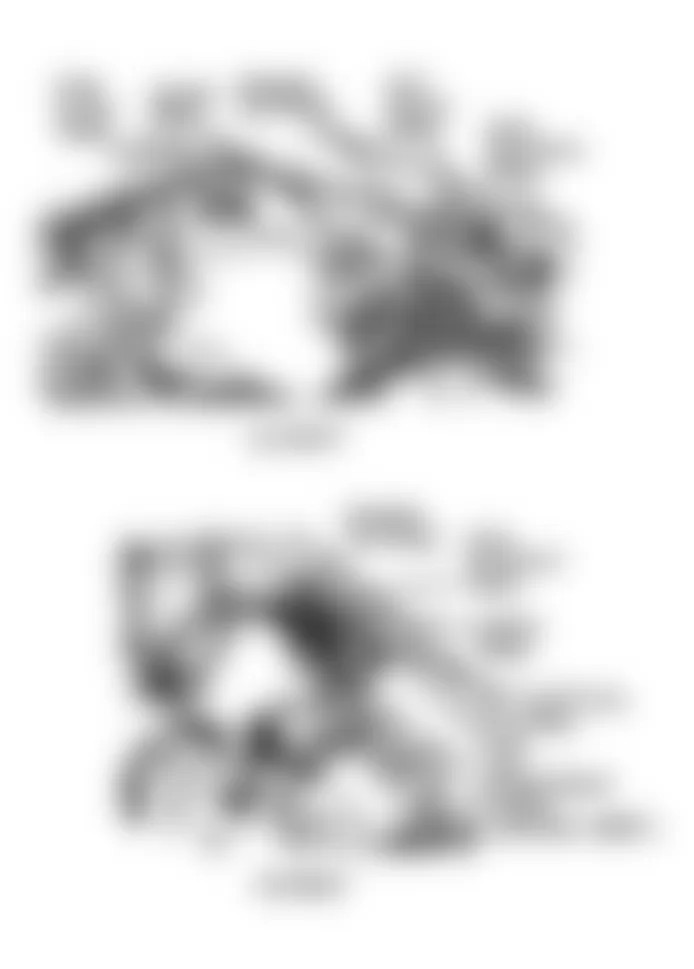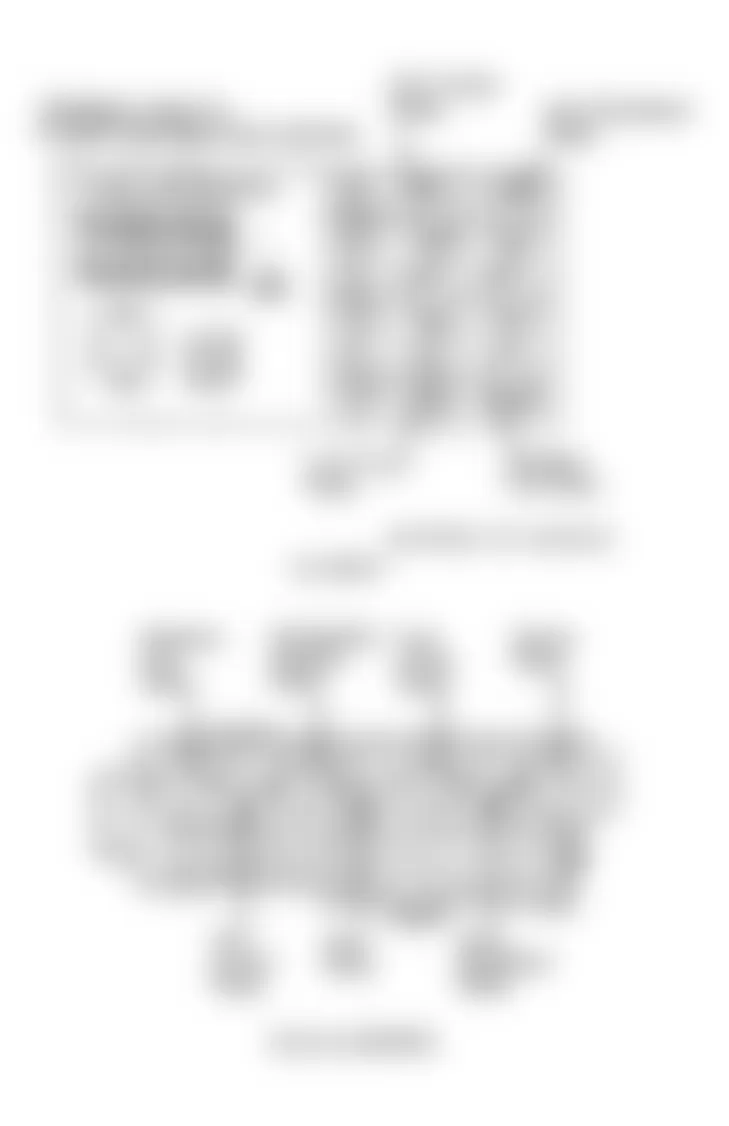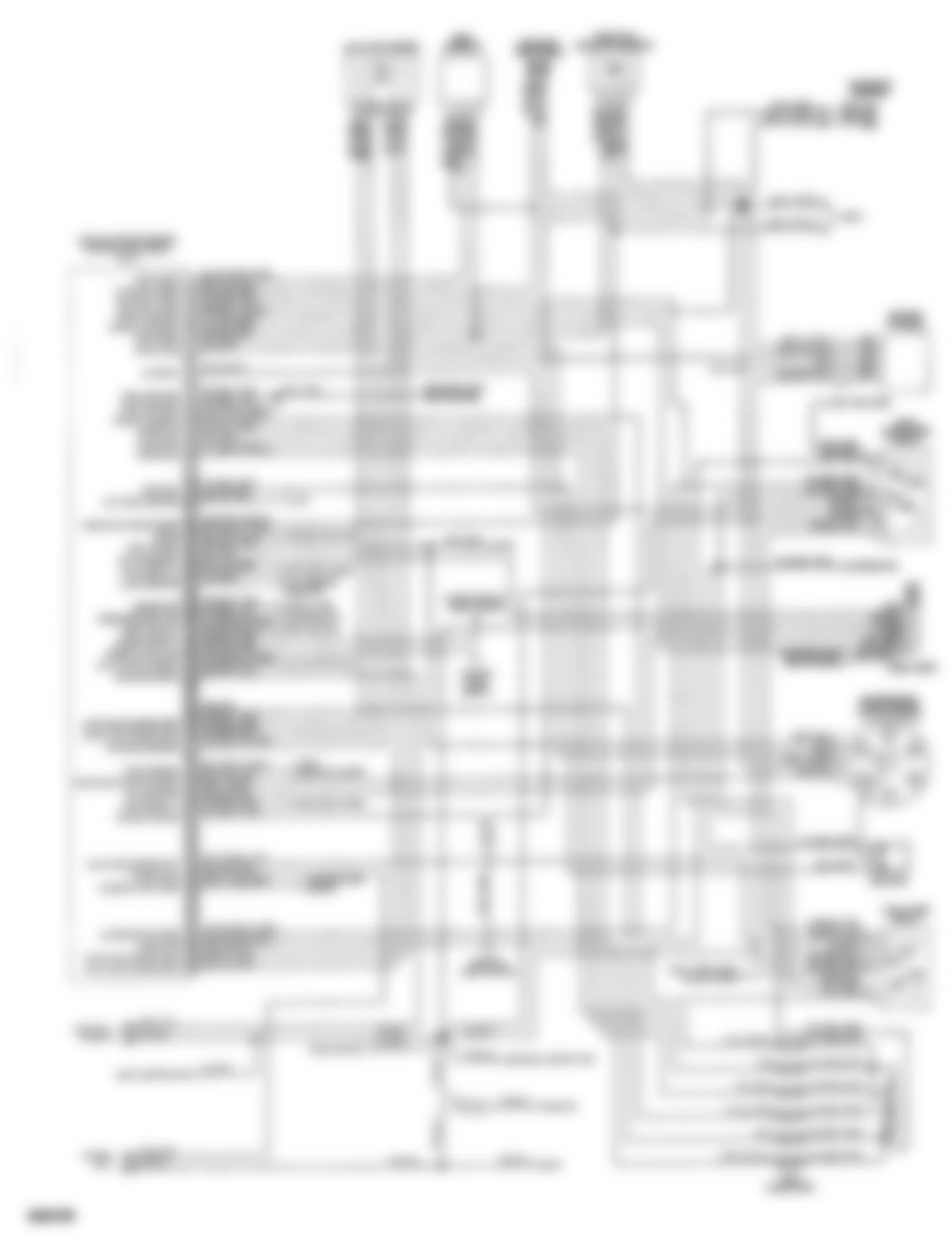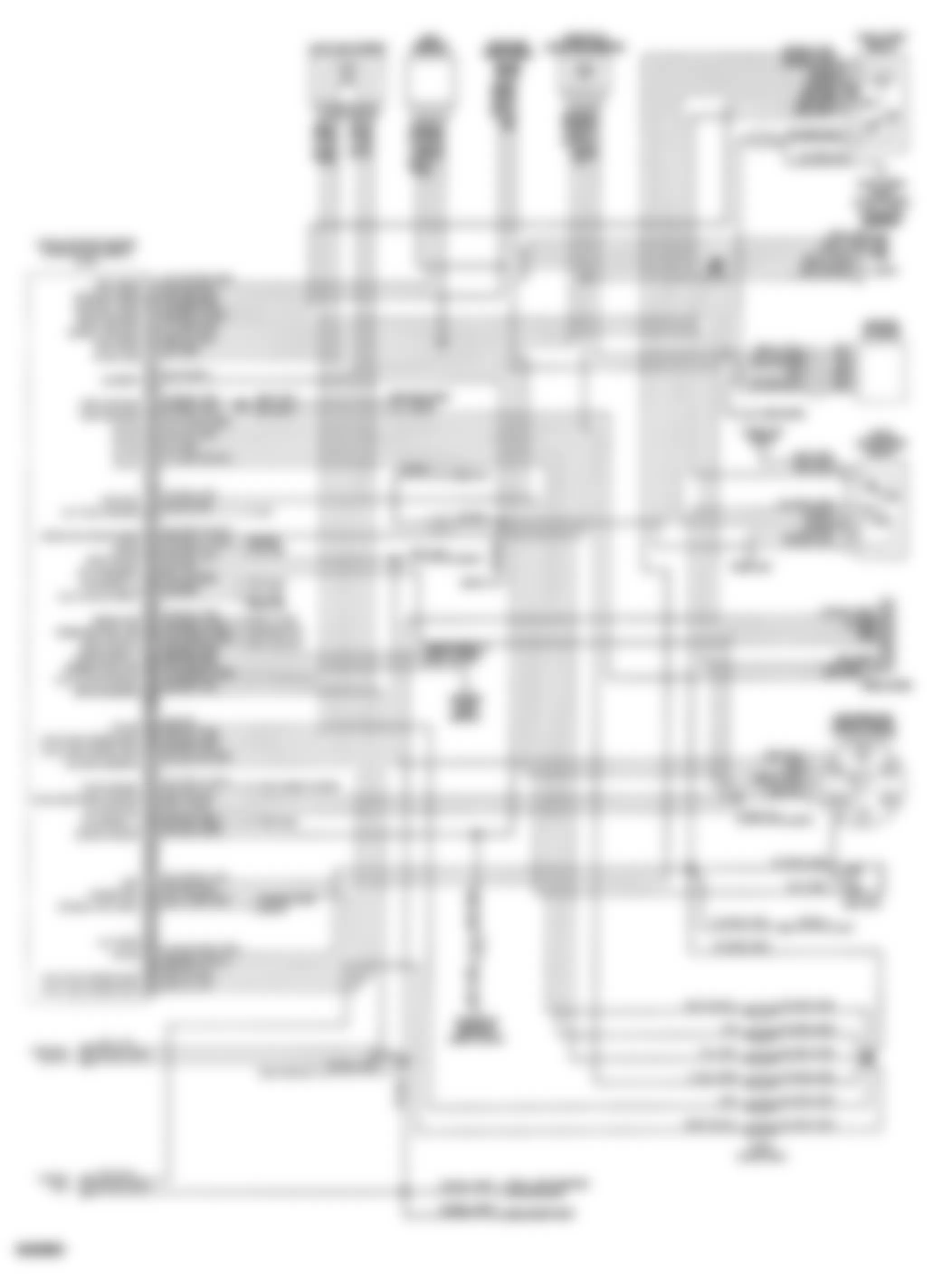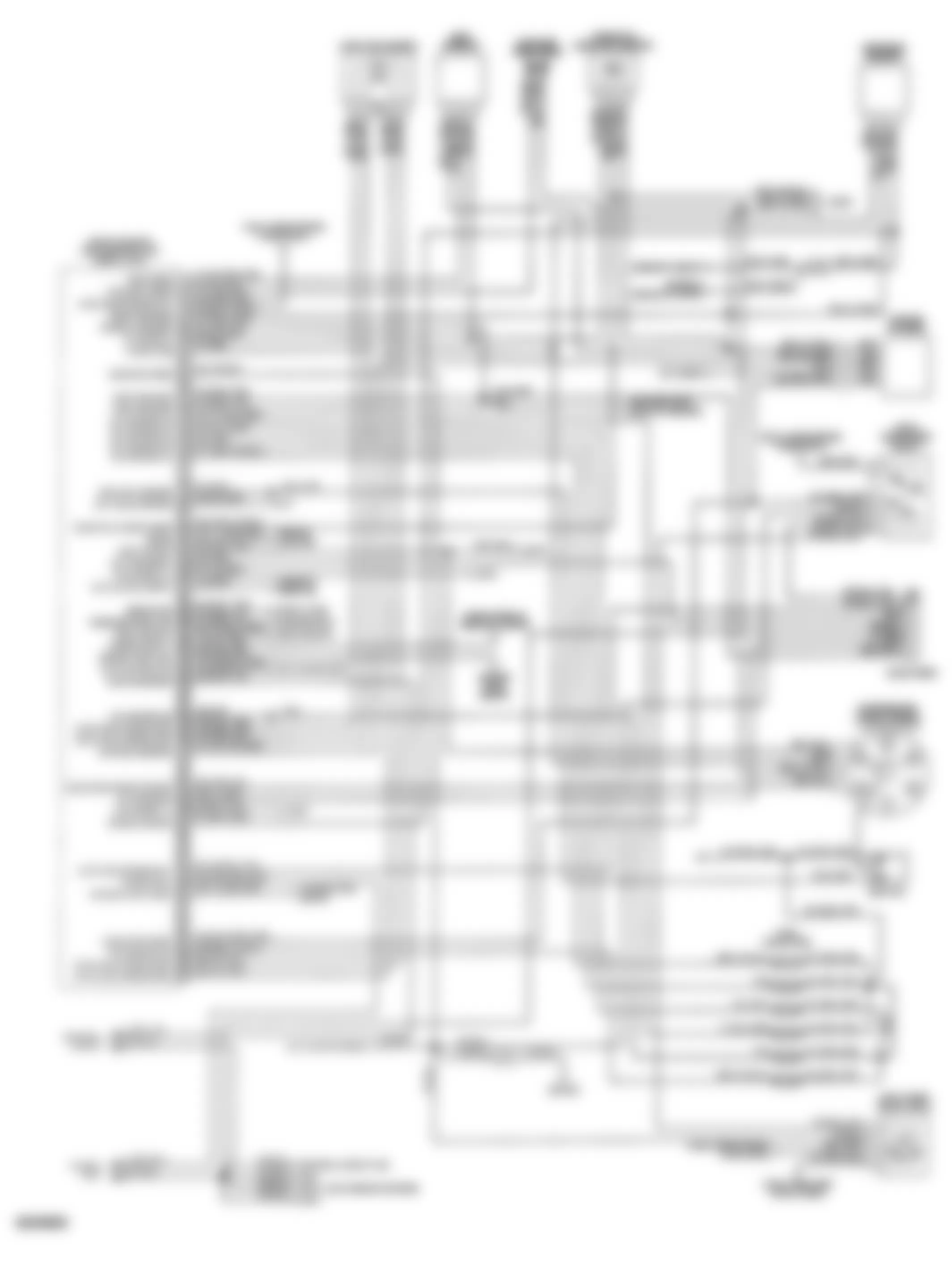Dodge Dynasty 1992 - 1992 ENGINE PERFORMANCE Self-Diagnostics - 3.0L (VIN 3)
Dodge Dynasty 1992 - INTRODUCTION
CAUTION: When battery is disconnected, vehicle computer and memory systems may lose memory data. Driveability problems may exist until computer systems have completed a relearn cycle. See COMPUTER RELEARN PROCEDURES in the GENERAL INFORMATION section before disconnecting battery.
If no faults were found while performing BASIC TESTING , proceed with self-diagnostics. If no fault codes or only pass codes are present after entering self-diagnostics, proceed to appropriate TESTS W/O CODES article in the ENGINE PERFORMANCE section for diagnosis by symptom (i.e., ROUGH IDLE, NO START, etc.).
Dodge Dynasty 1992 - MODEL IDENTIFICATION
Dodge Dynasty 1992 VEHICLE BODY IDENTIFICATION
Model Name Body Type Acclaim, LeBaron Sedan & Spirit AA Daytona AG Dynasty AC LeBaron Convertible/Coupe AJ Shadow & Sundance AP
Dodge Dynasty 1992 - SELF-DIAGNOSTIC SYSTEM
CAUTION: When battery is disconnected, vehicle computer and memory systems may lose memory data. Driveability problems may exist until computer systems have completed a relearn cycle. See COMPUTER RELEARN PROCEDURES in the GENERAL INFORMATION section before disconnecting battery.
Dodge Dynasty 1992 - SYSTEM DIAGNOSTICS
The self-diagnostic capabilities of this system, if properly utilized, can simplify testing. The Single Board Engine Controller (SBEC) monitors several different engine control system circuits.
If a problem is sensed with a monitored circuit, SBEC memory stores a fault code, the CHECK ENGINE light glows and SBEC enters limp-in mode. In limp-in mode, SBEC compensates for component failure by substituting information from other sources. This allows vehicle operation until repairs can be made.
Once codes are known, see FAULT CODES table to determine the questionable circuit. Test circuits and repair or replace components as required. If problem is repaired or ceases to exist, the SBEC cancels fault code after 50 ignition on/off cycles. To clear codes, see CLEARING FAULT CODES.
A specific fault code results from a particular system failure. A fault code does not condemn a specific component; component is not necessarily the reason for failure. Fault codes only call out a probable malfunction area.
Dodge Dynasty 1992 - Hard Failures
Hard failures cause CHECK ENGINE light to glow and remain on until the malfunction is repaired. If light comes on and remains on (light may flash) during vehicle operation, cause of malfunction must be determined using self-diagnostic tests. If a sensor fails, SBEC will use a substitute value in its calculations, allowing engine to operate in limp-in mode. In this condition, vehicle will run, but driveability may be poor.
Dodge Dynasty 1992 - Intermittent Failures
Intermittent failures may cause CHECK ENGINE light to flicker or stay on until the intermittent fault goes away. However, the corresponding fault code will be retained in SBEC memory. If related fault does not reoccur within a certain time frame, related fault code will be erased from SBEC memory. Intermittent failures can be caused by a faulty sensor, bad connector or wiring related problems. See INTERMITTENTS in appropriate TESTS W/O CODES article in the ENGINE PERFORMANCE Section.
Dodge Dynasty 1992 - SERVICE PRECAUTIONS
Before proceeding with diagnosis, the following precautions must be followed:
- ALWAYS relieve fuel pressure before disconnecting any fuel injection-related component. DO NOT allow fuel to contact engine or electrical components. See FUEL PRESSURE RELEASE.
- When battery is disconnected, vehicle computer and memory systems may lose memory data. Driveability problems may exist until computer systems have completed a relearn cycle. See COMPUTER RELEARN PROCEDURES in the GENERAL INFORMATION section before disconnecting battery.
- Vehicle must have a fully charged battery and functional charging system.
- Probe SBEC 60-pin connector from pin side. DO NOT backprobe SBEC connector.
- DO NOT cause short circuits when performing electrical tests. This will set additional fault codes, making diagnosis of original problem more difficult.
- DO NOT use a test light instead of a voltmeter.
- When checking for spark, ensure coil wire is NO more than 1/4" from ground. If coil wire is more than 1/4" from ground, damage to vehicle electronics and/or SBEC may result.
- DO NOT prolong testing of fuel injectors or engine may hydrostatically (liquid) lock.
- Always repair lowest fault code number (CHECK ENGINE light) or first fault displayed (DRB-II) first.
- Always perform verification procedure test after repairs are made.
- Always disconnect DRB-II after use.
- Always disconnect DRB-II before charging battery.
Dodge Dynasty 1992 - VISUAL INSPECTION
Most driveability problems in the engine control system result from faulty wiring, poor electrical connections or leaking air and vacuum hose connections. To avoid unnecessary component testing, perform a visual inspection before beginning self-diagnostic tests.
Dodge Dynasty 1992 - DIAGNOSTIC PROCEDURE
NOTE: DO NOT skip any steps in self-diagnostic tests or incorrect diagnosis may result.
Always perform a visual inspection before attempting to diagnose engine control system problems. See VISUAL INSPECTION. Enter on-board diagnostics, and retrieve fault code(s). See ENTERING ON-BOARD DIAGNOSTICS. If fault codes are not present and/or DRB-II (Diagnostic Readout Box-II) is used, proceed to one of the following tests:
- Go to TEST NS-1A (NO-START TEST 1A) if a no-start condition exists or engine stalls after start-up. Perform indicated VERIFICATION PROCEDURE test after repairs. Ensure self-diagnostic tests apply to engine being tested.
- Go to TEST DR-1A (DRIVEABILITY TEST 1A) if engine runs but has performance problems. Perform indicated VERIFICATION PROCEDURE test after repairs. Ensure self-diagnostic tests apply to engine being tested.
- Go to TEST NF-1A (NO FAULT CODE TEST 1A) if a driveability problem exits and no fault codes are present. Perform indicated VERIFICATION PROCEDURE test after repairs. Ensure self-diagnostic tests apply to engine being tested.
Dodge Dynasty 1992 - ENTERING ON-BOARD DIAGNOSTICS
NOTE: Although other scan testers are available, manufacturer recommends using DRB-II (Diagnostic Readout Box II) to diagnose the system. CHECK ENGINE light function can be used but has limited diagnostic usage.
Dodge Dynasty 1992 - CHECK ENGINE Light Diagnostic Mode
- Start engine (if possible). Move transmission shift lever through all positions, ending in PARK. Turn A/C switch on and then off (if equipped).
- Turn engine off. Without starting engine again, turn ignition on, off, on, off and on. Record 2-digit fault codes as displayed by flashing CHECK ENGINE light.
- For example, Code 23 is displayed as flash, flash, 4-second pause, flash, flash, flash. After a slightly longer pause, other codes stored are displayed in numerical order.
- When CHECK ENGINE light begins to flash fault codes, it cannot be stopped. Start over if count is lost. Code 55 indicates end of fault code display.
- - FAULT CODES table to translate trouble code number to a system fault description (DRB-II display). Once trouble area is identified, refer to appropriate TEST NS-1A (NO-START TEST 1A) or TEST DR-1A (DRIVEABILITY TEST 1A) to diagnose problem. Use self-diagnostic test titles to find appropriate test.
- As an example, a 3.0L engine starts and runs but has a driveability problem. CHECK ENGINE light indicates a Code 14. - FAULT CODES table to translate trouble code number to a system fault description (DRB-II display).
- When system fault description (DRB-II display) is obtained, refer to appropriate TEST DR-1A (DRIVEABILITY TEST DR-1A) since vehicle has a driveability problem. Select fault message and corresponding test from table, and proceed to appropriate test. To clear fault codes, see CLEARING FAULT CODES.
Dodge Dynasty 1992 - DRB-II Diagnostic Mode
- Turn ignition off. Connect DRB-II to engine diagnostic connector. Engine diagnostic connector is located in engine compartment, near SBEC.
- Start engine (if possible). With foot on brake, move transmission shift lever through all positions, ending in PARK. Turn A/C switch on and then off (if equipped).
- Turn engine off. Without starting engine again, turn ignition on. Enter FUEL/IGN MENU. To enter FUEL/IGN MENU, see FUEL/IGN MENU under DRB-II TEST FUNCTIONS. At FUEL/IGN MENU, press "2" (READ FAULTS) key. Press ENTER key. After fault codes are accessed, see appropriate TEST NS-1A (NO-START TEST 1A) or TEST DR-1A (DRIVEABILITY TEST 1A) to diagnose problem.
- To erase fault codes while in this mode, press ATM key. At DRB-II display, press "2" (ERASE) key. DRB-II will display ERASE FAULTS ARE YOU SURE? (ENTER TO ERASE). Press ENTER key.
- When DRB-II is finished erasing fault codes, it will display FAULTS ERASED. This display will remain until ATM key is pressed. After ATM key is pressed, display will return to FUEL/IGN MENU screen.
Dodge Dynasty 1992 - CLEARING FAULT CODES
NOTE: Fault codes can also be cleared in READ FAULTS mode of DRB-II. To ensure all faults are read, use READ FAULTS mode to erase fault codes. See DRB-II DIAGNOSTIC MODE under ENTERING ON-BOARD DIAGNOSTICS.
- If DRB-II is not available, go to step 3). If DRB-II is available, enter FUEL/IGN MENU. See FUEL/IGN MENU under DRB-II TEST FUNCTIONS. At FUEL/IGN MENU, press "5" (ADJUSTMENTS) key. Press ENTER key. At ADJUSTMENTS menu, press "1" (ERASE FAULTS) key. Press ENTER key.
- DRB-II will display ERASE FAULTS ARE YOU SURE? (ENTER TO ERASE). Press ENTER key. When DRB-II is finished erasing fault codes, screen will display FAULTS ERASED.
- If DRB-II is not available, fault codes may be cleared by disconnecting negative battery cable for at least 15 seconds, allowing SBEC to clear fault codes.
Dodge Dynasty 1992 - SUMMARY
If no hard fault codes (or only pass codes) are present, driveability symptoms exist or intermittent codes exist, proceed to appropriate TESTS W/O CODES article in the ENGINE PERFORMANCE Section for diagnosis by symptom (i.e., ROUGH IDLE, NO START, etc.) or intermittent diagnostic procedures.
Dodge Dynasty 1992 - DTC & FAULT CODES/MESSAGES FAULT CODES/MESSAGES (Note: For DTC table, see TEST NS-1A under "Testing.")
Dodge Dynasty 1992 FAULT CODES
Code Display On DRB-II (1) Fault Condition 11 NO REFERENCE SIGNAL DURING CRANKING No distributor reference signal picked up during cranking. 13 SLOW CHANGE IN MAP SIGNAL MAP output change is slower and/or smaller than expected. 13 NO CHANGE IN MAP FROM START TO RUN No difference recognized between MAP reading and barometric (atmospheric) pressure reading at start-up. 14 MAP VOLTAGE TOO LOW MAP sensor input less than minimum acceptable voltage. 14 MAP VOLTAGE TOO HIGH MAP sensor input more than minimum acceptable voltage. 15 NO VEHICLE SPEED SIGNAL No distance sensor signal detected with road load conditions. 17 ENGINE COLD TOO LONG Coolant temperature stays less than normal operating temperature during vehicle operation. 21 O2 SIGNAL STAYS AT CENTER No rich or lean signal is detected from O2 sensor input. 21 O2 SIGNAL SHORTED TO VOLTAGE O2 sensor input voltage maintained at more than normal operating range. 22 COOLANT SENSOR VOLTAGE TOO LOW Coolant temperature sensor input less than minimum acceptable voltage. 22 COOLANT SENSOR VOLTAGE TOO HIGH Coolant temperature sensor input more than maximum acceptable voltage. 23 CHARGE TEMPERATURE TOO LOW Charge temperature sensor input less than minimum acceptable voltage. 23 CHARGE TEMPERATURE VOLTAGE HI Charge temperature sensor input more than maximum acceptable voltage. 24 TPS VOLTAGE LOW TPS sensor input less than minimum acceptable voltage. 24 TPS VOLTAGE HIGH TPS sensor input more than maximum acceptable voltage. 25 AIS MOTOR CIRCUITS Open or shorted condition detected in one or more Auto Idle Speed (AIS) control circuits. 26 INJECTOR NO. 1 PEAK CURRENT NOT REACHED High resistance condition detected in injector No. 1 injector bank circuit. 26 INJECTOR NO. 2 PEAK CURRENT NOT REACHED High resistance condition detected in injector No. 2 injector bank circuit. 26 INJECTOR NO. 3 PEAK CURRENT NOT REACHED High resistance condition detected in injector No. 3 injector bank circuit. 27 INJECTOR CONTROL CIRCUIT Injector output driver does not respond properly to SBEC control signal. 27 INJECTOR NO. 1 CONTROL CIRCUIT Injector No. 1 injector bank output driver stage does not respond correctly to SBEC control signal. 27 INJECTOR NO. 2 CONTROL CIRCUIT Injector No. 2 injector bank output driver stage does not respond correctly to SBEC control signal. 27 INJECTOR NO. 3 CONTROL CIRCUIT Injector No. 3 injector bank output driver stage does not respond correctly to SBEC control signal. 31 PURGE SOLENOID CIRCUIT Open or shorted condition is deteced in purge solenoid circuit. 32 EGR SOLENOID CIRCUIT Open or shorted condition is detected in EGR transducer solenoid circuit. 32 EGR SYSTEM FAILURE SBEC did not detect required air/fuel change during diagnostic test. 33 A/C CLUTCH RELAY CIRCUIT Open or shorted condition detected in A/C clutch relay circuit. 34 S/C SOLENOIDS CIRCUIT Open or shorted condition detected in Speed Control (S/C) vacuum or vent solenoid circuits. 35 RADIATOR FAN RELAY CIRCUIT Open or shorted condition detected in radiator fan relay circuit. 36 WASTEGATE SOLENOID Open or shorted condition detected in turbocharger wastegate control solenoid circuit. 37 PTU SOLENOID CIRCUIT, TORQUE CONVERTER UNLOCK SOLENOID CIRCUIT An open or shorted condition detected in torque converter Part Throttle Unlock solenoid circuit. 41 (2) ALTERNATOR FIELD CIRCUIT An open or shorted condition detected in alternator field circuit. 42 ASD RELAY CIRCUIT An open or shorted condition detected in ASD relay circuit. 43 IGNITION COIL NO. 1 PRIMARY CIRCUIT Peak primary circuit current not achieved with maximum dwell time. 43 IGNITION COIL NO. 2 PRIMARY CIRCUIT Peak primary circuit current not achieved with maximum dwell time. 43 IGNITION COIL NO. 3 PRIMARY CIRCUIT Peak primary circuit current not achieved with maximum dwell time. 44 (2) BATTERY TEMPERATURE VOLTAGE An oopen or shorted condition exists in coolant temperature sensor circuit or in SBEC battery temperature voltage circuit. 45 TURBO BOOST LIMIT EXCEEDED MAP reading more than overboost limit detected during engine operation. 46 (2) CHARGING VOLTAGE TOO HIGH Battery voltage sense input more than target charging voltage during engine operation. 47 (2) CHARGING VOLTAGE TOO LOW Battery voltage sense input less than target charging voltage during engine operation and no significant change in voltage detected during active test of alternator output. 51 O2 SIGNAL STAYS BELOW CENTER (LEAN) O2 sensor input indicates lean air/fuel ratio during engine operation. 52 O2 SIGNAL STAYS ABOVE CENTER (RICH) O2 sensor input indicates rich air/fuel ratio during engine operation. 53 INTERNAL CONTROLLER FAILURE SBEC detects internal failure. 53 INTERNAL SBEC FAILURE/CONTROLLER FAILURE SPI COMMUNICATIONS No internal communication between coprocessors. 54 NO SYNC PICK-UP SIGNAL No high data rate detected during engine rotation. 55 (3) Completion of fault code display by CHECK ENGINE light. 61 BARO READ SOLENOID An open or shorted condition detected in barometric read solenoid circuit. 63 SBEC FAILURE EEPROM WRITE DENIED Unsuccessful attempt to write to an EEPROM location by SBEC. 77 SPEED CONTROL POWER RELAY CIRCUIT Open or shorted condition detected in speed control power relay circuit.
(1) Actual message displayed on DRB-II may vary between vehicles.
(2) If code is displayed, charging system malfunction exists. See appropriate ALTERNATORS & REGULATORS article in the ELECTRICAL section.
(3) No display on DRB-II.
Dodge Dynasty 1992 - DRB-II TEST FUNCTIONS
CAUTION: When battery is disconnected, vehicle computer and memory systems may lose memory data. Driveability problems may exist until computer systems have completed a relearn cycle. See COMPUTER RELEARN PROCEDURES in the GENERAL INFORMATION section before disconnecting battery.
Dodge Dynasty 1992 - FUEL/IGN MENU
NOTE: DO NOT touch DRB-II keypad during DRB-II power-up sequence or an error message will result.
- In order to perform self-diagnostic tests using DRB-II, DRB-II must be in the FUEL/IGN MENU. At the FUEL/IGN MENU, fault codes and DRB-II test functions can be accessed.
- To reach FUEL/IGN MENU, turn ignition off. Connect DRB-II to engine diagnostic connector, located in engine compartment, near SBEC. Turn ignition switch to RUN position.
- All DRB-II character positions will glow and copyright information will appear on screen for a few seconds. If screen is blank or any error messages appear, see DRB-II PROBLEMS & ERROR MESSAGES.
- After a few seconds, DRB-II menu will appear. At DRB-II menu, press "4" (SELECT SYSTEM) key. Press ENTER key. At SELECT SYSTEM menu, press "1" (ENGINE) key. Press ENTER key. DRB-II screen will indicate engine year, size, type of transmission and SBEC part number.
- After a few seconds, AIR COND menu will appear. Press "1" (WITH A/C) or "2" (WITHOUT A/C). DRB-II display will change to ENGINE SYSTEMS menu. At ENGINE SYSTEMS menu, press "1" (FUEL/IGNITION) key. Press ENTER key.
- Display will change to FUEL/IGN menu. At FUEL/IGN menu of engine diagnostic program, specific test functions programmed into DRB-II can be performed. The following DRB-II modes can be accessed: SYSTEM TEST, READ FAULTS, STATE DISPLAYS, ACTUATOR TEST and ADJUSTMENTS.
Dodge Dynasty 1992 - SYSTEM TEST Mode
This mode is not available in the engine diagnostics program.
Dodge Dynasty 1992 - READ FAULTS Mode
This mode allows user to read and erase fault codes. A fault counter will appear along with fault displayed. As an example, DRB-II will display 1 OF 2 FAULTS. SBEC will store up to 8 fault messages. Faults are numbered in reverse order of setting. The most recent fault to occur will be displayed first. Vehicles without air conditioning will always have A/C CLUTCH RELAY CKT (circuit) stored in memory. This fault will always be displayed first if vehicle is not equipped with A/C. If no fault messages are stored, DRB-II will display NO FAULTS DETECTED and start counter will show 0 STARTS SINCE ERS (Erased).
A start counter will appear below DRB-II fault counter display. Start counter counts the number of times vehicle is started since faults were last set or erased or battery was disconnected. This helps determine if fault is intermittent. Memory space limits start counter to first 3 faults. Start counter of zero equals a hard fault. Start counter of more than zero indicates an intermittent fault. Start counter will count up to 255 starts. If no fault messages are stored, DRB-II will display NO FAULTS DETECTED and start counter will show 0 STARTS SINCE ERS (Erased).
Dodge Dynasty 1992 - STATE DISPLAYS Mode
This mode provides access to FUEL/IGN STATE menu. FUEL/IGN STATE menu permits viewing groups of data regarding the SBEC, sensor and switch inputs, controlled outputs, and predetermined or user selectable groups of data. The following modes can be accessed from the FUEL/IGN STATE menu: MODULE INFO, SENSORS, INPUTS/OUTPUTS, MONITORS and CUSTOM DISPLAYS. For information about the function of these modes, see FUEL/IGN STATE MENU.
Dodge Dynasty 1992 - ACTUATOR TEST Mode
This mode allows the user to check for proper operation of output circuits or devices which the SBEC cannot internally recognize. DRB-II allows SBEC to activate these outputs or devices, allowing an observer to verify proper operation.
Most of the tests available in this mode provide an audible or visual indication of device operation (click of relay contacts, spray fuel, etc.). With the exception of an intermittent condition, if a device functions properly during its test, the device, wiring and its driver circuit are presumably functioning properly.
Dodge Dynasty 1992 - ADJUSTMENTS Mode
This mode allows the opportunity to make adjustments to SBEC memory. The following modes can be accessed from the ADJUSTMENTS menu: ERASE FAULTS, RESET MEMORY and EMR MEMORY CHECK. For information about the function of these modes, see ADJUSTMENTS MENU.
Dodge Dynasty 1992 - ADJUSTMENTS MENU ERASE FAULTS Mode
This mode erases fault messages which are stored in SBEC memory. Once this mode is selected, DRB-II displays ARE YOU SURE? If fault erasure is not desired, press ATM key. If fault erasure is desired, press ENTER key; all faults and secondary indicators will be erased.
Dodge Dynasty 1992 - RESET MEMORY Mode
This mode provides a sub-menu listing resettable memories. As vehicle is operated, SBEC learns to adjust fuel delivery, automatic idle speed motor position and minimum throttle position sensor signal voltage to compensate for different engine operating conditions. The following modes can be accessed from the RESET MEMORY menu: ADAPTIVE FUEL, AIS COUNTER, MINIMUM TPS and ALL VALUES. For additional information about the function of these modes, see RESET MEMORY MENU.
Dodge Dynasty 1992 - FUEL/IGN STATE MENU MODULE INFO Mode
Mode displays model year, engine displacement, emission type, transmission type and SBEC part number.
Dodge Dynasty 1992 - SENSORS Mode
This mode provides a list of sensors and their input value to the SBEC.
Dodge Dynasty 1992 - INPUTS/OUTPUTS Mode
This mode provides a list of input switch and output device circuits and status.
Dodge Dynasty 1992 - MONITORS Mode
This mode provides access to MONITORS menu. MONITORS menu displays up to 12 inputs and outputs relating to a specific area of fuel and ignition system performance. The following modes can be accessed from the MONITORS menu: FUEL CONTROL, ADVANCE, RPM, ADAPTIVE MEM, NO START, INTERROGATOR and SEC INDICATORS. For additional information about the function of these modes, see MONITORS MENU.
Dodge Dynasty 1992 - CUSTOM DISPLAYS Mode
This mode allows the user to customize DRB-II display. The user can select up to 4 different displays which can be shown on a single screen. Any item from inputs/output list, sensor list or actuator list can be selected from the custom display. Once selected, custom display will be retained in memory until changed. Up to 2 custom display screens can be customized by user.
Dodge Dynasty 1992 - MONITORS MENU FUEL CONTROL Mode
This mode allows the user to display inputs and outputs which affect fuel delivery.
Dodge Dynasty 1992 - ADVANCE Mode
This mode allows the user to display inputs and outputs which affect ignition timing advance.
Dodge Dynasty 1992 - RPM Mode
This mode allows the user to display inputs and outputs which affect engine speed.
Dodge Dynasty 1992 - ADAPTIVE MEM Mode
This mode allows the user to display inputs and outputs which affect adaptive memory. As a vehicle is operated, SBEC learns to adjust fuel delivery, automatic idle speed motor position and minimum throttle position sensor signal voltage to compensate for different engine operating conditions.
Dodge Dynasty 1992 - NO START Mode
This mode allows the user to display inputs and outputs which affect engine starting.
Dodge Dynasty 1992 - INTERROGATOR Mode
This mode displays selectable inputs and outputs for use during the engineering process. This mode is not available in the engine diagnostics program.
Dodge Dynasty 1992 - SEC INDICATORS Mode
This mode allows user to display inputs and outputs which are not within optimum parameters but have not yet become faults. Secondary indicators are monitored by the DRB-II at all times after engine is selected in SELECT SYSTEM menu. When a secondary indicator is generated, DRB-II will emit 5 short beeps. If a secondary indicator becomes a hard fault, DRB-II red LED (light emitting diode) will glow.
Dodge Dynasty 1992 - RESET MEMORY MENU ADAPTIVE FUEL Mode
This mode allows the user to erase SBEC memory of learned fuel delivery. As a vehicle is operated, SBEC learns to adjust fuel delivery, automatic idle speed motor position and minimum throttle position sensor signal voltage to compensate for different engine operating conditions.
Dodge Dynasty 1992 - AIS COUNTER Mode
This mode allows the user to erase SBEC memory of start-up Automatic Idle Speed (AIS) motor steps.
Dodge Dynasty 1992 - MINIMUM TPS Mode
This mode allows the user to erase SBEC memory of lowest Throttle Position Sensor (TPS) voltage.
Dodge Dynasty 1992 - ALL VALUES Mode
This mode allows the user to erase SBEC memory of adaptive fuel delivery, automatic idle speed motor position and minimum throttle position sensor signal voltage.
Dodge Dynasty 1992 - DRB-II VOLT/OHMMETER
- To access volt/ohmmeter mode of DRB-II, connect Red volt/ohmmeter test lead to Red port, located on right top side of DRB-II.
NOTE: Because DRB-II is grounded through engine diagnostic connector, only one volt/ohmmeter test lead is required when using volt/ohmmeter option. DRB-II volt/ohmmeter should only be used when self-diagnostic tests require the use of this option. - To access voltmeter, press VOLT/OHM key once. DRB-II is now in voltmeter mode. Touch test probe to connector or wire to be measured. Read voltage on DRB-II display. When voltage testing is complete, press VOLT/OHM key 3 times to exit voltmeter mode.
- To access ohmmeter, press VOLT/OHM key twice. DRB-II is now in ohmmeter mode. Touch test probe to connector or wire to be measured. Read resistance to circuit ground on DRB-II display. When resistance testing is complete, press VOLT/OHM key twice to exit ohmmeter mode.
Dodge Dynasty 1992 - DRB-II Continuity Meter Mode
Press VOLT/OHM key 3 times. Display will read NO CONTINUITY. Touch test probe to connector or wire to be measured. Read continuity on DRB-II display. When continuity testing is complete, press VOLT/OHM key once to exit continuity meter mode.
Dodge Dynasty 1992 - DRB-II PROBLEMS & ERROR MESSAGES Blank Message Screen
- Connect DRB-II to a different vehicle. If message screen is still blank, DRB-II or cable adapter are faulty. Substitute to find faulty component.
- If message screen is not blank, DRB-II and cable adapter are functioning properly. Inspect diagnostic connector for proper wire placement, damaged terminals and pushed-out pins. Repair as necessary.
- If engine diagnostic connector is okay, check for continuity between Black/tracer wire (tracer color may vary) and ground at engine diagnostic connector using an ohmmeter. If continuity does not exist, repair open in Black/tracer wire.
Dodge Dynasty 1992 - NO RESPONSE Message
- Connect DRB-II to another vehicle. If DRB-II displays NO RESPONSE message again, DRB-II or cable adapter are faulty. Substitute to find faulty component. If message screen does not display NO RESPONSE, DRB-II and cable adapter are functioning properly. Go to next step.
- Turn ignition off. Disconnect DRB-II. Using an ohmmeter, check Pink wire for continuity between SBEC connector terminal No. 25 and engine diagnostic connector. If continuity does not exist, repair open in Pink wire.
- If continuity exists, check Light Green wire for continuity between SBEC connector terminal No. 45 and engine diagnostic connector. If continuity does not exist, repair open in Light Green wire.
Dodge Dynasty 1992 - RAM TEST FAILURE Message
Replace DRB-II.
Dodge Dynasty 1992 - CARTRIDGE ERROR OR ROM CHECKSUM FAILURE Message
Replace DRB-II cartridge.
Dodge Dynasty 1992 - KEYPAD TEST FAILURE Message
Ensure ignition is off. DO NOT touch keypad on DRB-II. Turn ignition on. If DRB-II displays KEYPAD TEST FAILURE message, replace DRB-II, and proceed with diagnostics. If KEYPAD TEST FAILURE message is not displayed, proceed with diagnostics.
NOTE: HIGH BATTERY or LOW BATTERY message may not be displayed on all models.
Dodge Dynasty 1992 - HIGH BATTERY OR LOW BATTERY Message
If message is displayed, connect DRB-II to a different vehicle. If message is still present, DRB-II or adapter cable are faulty. Substitute components as needed. If DRB-II and adapter cable are okay, check charging system.
Dodge Dynasty 1992 - FUEL PRESSURE RELEASE
WARNING: Always relieve fuel pressure before disconnecting any fuel injection-related component. DO NOT allow fuel to contact engine or electrical components.
- Slowly open fuel tank cap to release pressure in tank. To release remaining pressure in system, disconnect injector wiring harness connector.
- Ground injector harness connector terminal No. 1 using jumper wire. See Fig. 1. Using a second jumper wire, apply battery voltage to injector harness connector terminal No. 2.
- DO NOT apply battery voltage to terminal No. 2 for more than 5 seconds. Remove jumper wires. Connect injector wiring harness connector. Fuel pressure is now fully released.


Fig. 1: Dodge Dynasty 1992 - Component Locations - Injector Harness Connector Terminal ID (V6)
Dodge Dynasty 1992 - CONNECTOR IDENTIFICATION
Dodge Dynasty 1992 CONNECTOR IDENTIFICATION
Connector See
Fig. Automatic Idle Speed Motor Fig. 3 Coolant Temperature Sensor Fig. 4 Distance Sensor Fig. 5 Distributor Harness Fig. 6 EGR Solenoid Fig. 7 Fuel Injector Fig. 8 Fuel Injector Harness Fig. 9 Fuel Pump Harness Fig. 10 Ignition Coil Fig. 11 Lock-Up Solenoid Fig. 12 MAP Sensor Fig. 13 Oxygen (O2) Sensor Fig. 14 Purge Solenoid Fig. 7 Relays Fig. 2 SBEC Fig. 15 Throttle Position Sensor Fig. 16
Fig. 3: Dodge Dynasty 1992 - Component Locations - Automatic Idle Speed Motor Connector Terminal ID
Fig. 4: Dodge Dynasty 1992 - Component Locations - Coolant Temperature Sensor Connector Terminal ID
Fig. 5: Dodge Dynasty 1992 - Component Locations - Distance Sensor Connector Terminal ID
Fig. 6: Dodge Dynasty 1992 - Component Locations - Distributor Harness Connector Terminal ID
Fig. 7: Dodge Dynasty 1992 - Component Locations - EGR & Purge Solenoid Connector Terminal ID
Fig. 8: Dodge Dynasty 1992 - Component Locations - Fuel Injector Connector Terminal ID
Fig. 9: Dodge Dynasty 1992 - Component Locations - Fuel Injector Harness 8-Pin Connector Terminal ID
Fig. 10: Dodge Dynasty 1992 - Component Locations - Fuel Pump Harness Connector Terminal ID
Fig. 11: Dodge Dynasty 1992 - Component Locations - Ignition Coil Connector Terminal ID
Fig. 12: Dodge Dynasty 1992 - Component Locations - Lock-Up Solenoid Connector Terminal ID
Fig. 13: Dodge Dynasty 1992 - Component Locations - MAP Sensor Connector Terminal ID
Fig. 14: Dodge Dynasty 1992 - Component Locations - Oxygen (O2) Sensor Connector Terminal ID
Fig. 16: Dodge Dynasty 1992 - Component Locations - Throttle Position Sensor Connector Terminal ID
Dodge Dynasty 1992 - SELF-DIAGNOSTIC TESTS
NOTE: In the following self-diagnostic tests, illustrations are courtesy of Chrysler Motors.
Dodge Dynasty 1992 - TEST NS-1A - CHECKING FOR FAULTS & SPARK
NOTE: For connector terminal identification, see CONNECTOR IDENTIFICATION. For appropriate wiring diagram, see WIRING DIAGRAMS.
- Ensure battery is fully charged. Disconnect and reconnect battery disconnect cable. Try to start engine by cranking for at least 10 seconds, ensuring ignition switch is turned to OFF position before each attempt to start engine. Turn ignition switch to ON position, and read DRB-II fault messages. See DRB-II FAULT MESSAGES table.
Dodge Dynasty 1992 DRB-II FAULT MESSAGES
DTC DRB-II Message Test No. NO RESPONSE NS-8A Code 22 & 24 COOLANT VOLTAGE AND TPS VOLTAGE HIGH (1) Code 11 NO REFERENCE SIGNAL DURING CRANKING NS-9A Code 42 AUTO SHUTDOWN RELAY CONTROL CIRCUIT NS-10A Code 42 NO ASD RELAY VOLTAGE SENSE AT CONTROLLER NS-11A Code 27 INJECTOR CONTROL CIRCUIT NS-5A Code 25 AUTOMATIC IDLE SPEED MOTOR CIRCUITS NS-6A Code 53 INTERNAL CONTROLLER FAILURE (2) Code 53 CONTROLLER FAILURE SPI COMMUNICATIONS (2) (1) Repair open Black/Light Blue wire at engine controller cavity No. 4. Perform VERIFICATION PROCEDURE VER-1. (2) Replace engine controller. Perform VERIFICATION PROCEDURE VER-1. - If no fault messages are present, turn ignition switch to OFF position. Try to start engine by cranking for at least 10 seconds. Ensure ignition is turned to OFF position before each attempt to start engine.
- If engine starts and then stalls, perform TEST NS-2A. If engine does not start and stall, turn ignition switch to OFF position. Disconnect any spark plug cable at spark plug. Insert an insulated screwdriver in cable terminal. Hold screwdriver within 1/4" of a good ground.
CAUTION: If spark plug cable is held more than 1/4" away from a good ground, Single Board Engine Controller (SBEC) damage may occur. - Watch for spark while cranking engine for 10 seconds. Consider 1-2 sparks as a no-spark condition. If a good spark exists, perform TEST NS-2A. If no spark exists, reconnect spark plug cable. Disconnect coil secondary cable from distributor cap. Hold coil secondary cable within 1/4" of a good ground.
- Watch for spark while cranking engine for 10 seconds. If a good spark exists, repair secondary ignition (distributor cap, rotor and cables). Perform VERIFICATION PROCEDURE VER-1. If a good spark does not exist, remove secondary cable from coil. Using an ohmmeter, check coil secondary cable resistance. If resistance is more than 15,000 ohms, replace coil secondary cable. Perform VERIFICATION PROCEDURE VER-1.
- If resistance is less than 15,000 ohms, remove distributor cap. Crank engine while observing distributor rotor rotation. If rotor does not turn when engine is cranked, repair distributor drive system. Perform VERIFICATION PROCEDURE VER-1. If rotor turns when engine is cranked, reinstall distributor cap. Disconnect ignition coil connector. Actuate fuel system using DRB-II.
- Put DRB-II in voltmeter mode while actuating fuel system. Probe ignition coil connector terminal No. 2 (Dark Green/Orange wire). If voltage is less than 10 volts, repair Dark Green/Orange or Dark Green/Black wire between ignition coil and Auto Shutdown (ASD) relay splice. Perform VERIFICATION PROCEDURE VER-1.
- If voltage is more than 10 volts, probe ignition coil connector terminal No. 1 (Black/Gray wire). If voltage is more than 10 volts, go to step 12). If voltage is less than 10 volts, turn ignition switch to OFF position. Disconnect Single Board Engine Controller (SBEC) 60-pin connector. Put DRB-II in ohmmeter mode. Probe SBEC connector terminal No. 19.
- If resistance is less than 10 ohms, repair Black/Gray wire for a short to ground. Perform VERIFICATION PROCEDURE VER-1. If resistance is more than 10 ohms, go to next step.
- Using an external ohmmeter, check Black/Gray wire for continuity between SBEC connector terminal No. 19 and ignition coil connector.
- If resistance is more than 10 ohms, repair Black/Gray wire for an open circuit. Perform VERIFICATION PROCEDURE VER-1. If resistance is less than 10 ohms, replace SBEC. Perform VERIFICATION PROCEDURE VER-1.
- If voltage in step 8) was more than 10 volts, turn ignition switch to OFF position. Using an external ohmmeter, check ignition coil primary circuit resistance. If resistance is not .8-1.3 ohms at 75?F (23.8?C), replace ignition coil. Perform VERIFICATION PROCEDURE VER-1.
- If resistance is as specified, check ignition coil secondary circuit. If resistance is not 10,000-16,000 ohms, replace ignition coil. Perform VERIFICATION PROCEDURE VER-1. If resistance is as specified, reconnect ignition coil connector. Perform TEST NS-9A.
Dodge Dynasty 1992 - TEST NS-2A - CHECKING FUEL SYSTEM
NOTE: For connector terminal identification, see CONNECTOR IDENTIFICATION. For appropriate wiring diagram, see WIRING DIAGRAMS.
- Turn ignition switch to ON position. If vehicle is equipped with a factory theft alarm, read theft alarm status using a DRB-II. Go to next step. If vehicle is not equipped with a factory theft alarm, go to step 3).
- If DRB-II does not display FUEL ON, perform theft alarm test. See G - BODY TESTS W/ CODES article in the ENGINE PERFORMANCE Section. Perform VERIFICATION PROCEDURE VER-1. If DRB-II displays FUEL ON, go to next step.
- Read Throttle Position Sensor (TPS) voltage. Ensure throttle is at idle position. If voltage is more than 1.5 volts, replace TPS. Perform VERIFICATION PROCEDURE VER-1.
- If voltage is less than 1.5 volts, disconnect fuel injector 8-pin harness connector. See Fig. 17. Place DRB-II in voltmeter mode. Actuate fuel system. Probe fuel injector 8-pin harness connector terminal No. 8 (Dark Green/Orange wire).
Fig. 17: Dodge Dynasty 1992 - Component Locations - Locating Fuel Injector 8-Pin Harness Connector - If voltage is less than 10 volts, repair open (Dark Green/Orange wire) between fuel injector 8-pin harness connector and harness splice. Perform VERIFICATION PROCEDURE VER-1.
WARNING: High fuel pressure may be present in fuel lines. Open fuel system with caution. See FUEL PRESSURE RELEASE procedure. - If voltage is more than 10 volts, turn ignition switch to OFF position. Reconnect fuel injector 8-pin harness connector. Install fuel pressure gauge in fuel rail fitting. Ensure fuel tank is at least 1/4 full. Actuate fuel system using DRB-II. Listen for fuel pump operation at fuel tank.
- If fuel pump operation cannot be heard, perform TEST NS-7A. If fuel pump operation can be heard, read fuel pressure gauge. If fuel pressure is more than 53 psi, perform TEST NS-4B. If pressure is less than 43 psi, perform TEST NS-4A. If vehicle starts and stalls repeatedly, perform TEST NS-12A. If vehicle does not start and stall repeatedly, perform TEST NS-3A.
Dodge Dynasty 1992 - TEST NS-3A - INSPECTING MECHANICAL SYSTEM
NOTE: For connector terminal identification, see CONNECTOR IDENTIFICATION. For appropriate wiring diagram, see WIRING DIAGRAMS.
- Turn ignition switch to OFF position. Remove all spark plugs, and inspect spark plug tips for wet fuel. Dry spark plugs as necessary. Reinstall spark plugs. Check spark plug cables for correct firing order. See Fig. 18. If firing order is incorrect, reconnect spark plug cables in correct firing order. Perform VERIFICATION PROCEDURE VER-1.
- If firing order is correct, disconnect coolant temperature sensor connector. Connect timing light. Check ignition timing while cranking engine. Perform TEST NS-3B if ignition timing is not 0-16 degrees BTDC. If timing is as specified, turn ignition switch to OFF position. Disconnect Single Board Engine Controller (SBEC) and MAP sensor connectors.
- Using an external ohmmeter, check resistance of Violet/White wire between SBEC connector terminal No. 6 and MAP sensor connector terminal No. 3. If resistance is more than 10 ohms, repair Violet/White wire for an open circuit. If resistance is less than 10 ohms, check valve timing and compression. Repair engine as necessary. Perform VERIFICATION PROCEDURE VER-1. If valve timing and compression are okay, replace MAP sensor. Perform VERIFICATION PROCEDURE VER-1.
Fig. 18: Dodge Dynasty 1992 - Component Locations - Checking Firing Order
Dodge Dynasty 1992 - TEST NS-3B - INSPECTING MECHANICAL SYSTEM
- Attempt to set basic ignition timing to 10 degrees BTDC. If ignition timing cannot be set, check valve timing, and repair as necessary. Perform VERIFICATION PROCEDURE VER-1. If ignition timing can be set to specification, attempt to start engine.
- If engine will not start, check for valve timing, compression and other mechanical failure. Repair as necessary. Perform VERIFICATION PROCEDURE VER-1. If engine starts, check valve timing. If valve timing is correct, test is complete. Perform VERIFICATION PROCEDURE VER-1. If valve timing is incorrect, repair as necessary. Perform VERIFICATION PROCEDURE VER-1.
Dodge Dynasty 1992 - TEST NS-4A - CHECKING FUEL DELIVERY
WARNING: High fuel pressure may be present in fuel lines. Open fuel system with caution. See FUEL PRESSURE RELEASE.
- Record fuel pressure gauge reading. Turn ignition switch to OFF position. Release fuel pressure. Remove fuel pressure gauge. Install fuel pressure gauge between fuel tank and fuel filter. Reconnect fuel line. With ignition switch in ON position, actuate fuel system using a DRB-II. Record fuel pressure gauge reading.
- Compare fuel pressure gauge reading with previous reading. If fuel pressure is at least 10 psi more than fuel pressure gauge reading previously recorded, inspect fuel lines between fuel filter and fuel rail for a restriction. If any restrictions exist, repair as necessary. Perform VERIFICATION PROCEDURE VER-1. If no restrictions exist, replace fuel filter. Perform VERIFICATION PROCEDURE VER-1.
CAUTION: DO NOT allow fuel pressure to exceed 70 psi when squeezing fuel return hose. - If fuel pressure was not at least 10 psi more, gently squeeze fuel return hose while watching fuel pressure gauge. If fuel pressure exceeds 43 psi, replace fuel pressure regulator. Perform VERIFICATION PROCEDURE VER-1. If pressure does not exceed 43 psi, replace fuel pump and sock filter. Perform VERIFICATION PROCEDURE VER-1.
Dodge Dynasty 1992 - TEST NS-4B - CHECKING FUEL DELIVERY
WARNING: High fuel pressure may be present in fuel lines. Open fuel system with caution. See FUEL PRESSURE RELEASE.
- Ensure fuel tank is at least 1/4 full before beginning this test. Release fuel pressure. Remove fuel return hose from fuel rail. Connect a 6' fuel hose to fuel rail return nipple. Place other end of hose into an approved 2-gallon gasoline container. Using DRB-II, actuate fuel system. Read fuel gauge.
- If fuel pressure is more than 53 psi, replace fuel pressure regulator. Perform VERIFICATION PROCEDURE VER-1. If fuel pressure is less than 53 psi, turn ignition switch to OFF position. Reconnect fuel return hose. Remove fuel return hose from fuel tank. Connect a 6' fuel hose to disconnected fuel return hose. Place other end of 6' fuel hose into an approved 2-gallon gasoline container.
- Turn ignition switch to ON position. Using DRB-II, actuate fuel system. Read fuel pressure gauge. If fuel pressure is less than 53 psi, replace fuel return assembly. Perform VERIFICATION PROCEDURE VER-1. If fuel pressure is more than 53 psi, repair restricted fuel return line between fuel rail and fuel tank. Perform VERIFICATION PROCEDURE VER-1.
Dodge Dynasty 1992 - TEST NS-5A - INJECTOR CONTROL CIRCUIT (DTC 27)
NOTE: For connector terminal identification, see CONNECTOR IDENTIFICATION. For appropriate wiring diagram, see WIRING DIAGRAMS.
- Turn ignition switch to OFF position. Disconnect and inspect fuel injector 8-pin harness connector. Repair connector as necessary. Perform VERIFICATION PROCEDURE VER-1. If connector is okay, turn ignition switch to ON position. Using DRB-II, actuate fuel system. Place DRB-II in voltmeter mode. Probe fuel injector 8-pin harness connector terminal No. 8 (Dark Green/Orange wire).
- If voltage is more than 10 volts, repair open Dark Green/Orange wire for an open between ignition coil connector and fuel injector 8-pin harness connector. Perform VERIFICATION PROCEDURE VER-1. If voltage is less than 10 volts, repair open in Dark Green/Orange wire between ASD relay and 8-pin connectors. Perform VERIFICATION PROCEDURE VER-1.
Dodge Dynasty 1992 - TEST NS-6A - AUTO IDLE SPEED (AIS) MOTOR CIRCUITS (DTC 25)
NOTE: For connector terminal identification, see CONNECTOR IDENTIFICATION. For appropriate wiring diagram, see WIRING DIAGRAMS.
- Disconnect Automatic Idle Speed (AIS) motor connector. Turn ignition switch to ON position. Using DRB-II, actuate AIS motor. Place DRB-II in voltmeter mode. Probe AIS motor connector terminal No. 1 (Gray/Red wire). Voltage should switch from less than one volt to more than 10 volts.
- If voltage stays less than one volt, repair Gray/Red wire for a short to ground. Perform VERIFICATION PROCEDURE VER-1. If voltage stays more than 10 volts, repair Gray/Red wire for a short to voltage. Perform VERIFICATION PROCEDURE VER-1.
- If voltage does not stay more than 10 volts, probe AIS motor connector terminal No. 2 (Yellow/Black wire). If voltage stays less than one volt, repair Yellow/Black wire for a short to ground. Perform VERIFICATION PROCEDURE VER-1. If voltage stays more than 10 volts, repair Yellow/Black wire for a short to voltage. Perform VERIFICATION PROCEDURE VER-1.
- If voltage does not stay more than 10 volts, probe AIS motor connector terminal No. 3 (Brown/White wire). If voltage stays less than one volt, repair Brown/White wire for short to ground. Perform VERIFICATION PROCEDURE VER-1. If voltage stays more than 10 volts, repair Brown/White wire for a short to voltage. Perform VERIFICATION PROCEDURE VER-1. If voltage does not stay more than 10 volts, probe AIS motor connector terminal No. 4 (Violet/Black wire).
- If voltage stays less than one volt, repair Violet/Black wire for a short to ground. Perform VERIFICATION PROCEDURE VER-1. If voltage stays more than 10 volts, repair Violet/Black wire for a short to voltage. Perform VERIFICATION PROCEDURE VER-1. If voltage does not stay more than 10 volts, turn ignition switch to OFF position. Reconnect AIS motor connector.
- Disconnect Single Board Engine Controller (SBEC) 60-pin connector. Using an external ohmmeter, check resistance between SBEC connector terminals No. 39 (Gray/Red wire) and 59 (Violet/Black wire). If resistance is less than 35 ohms, replace AIS motor. Perform VERIFICATION PROCEDURE VER-1.
- If resistance is more than 35 ohms, check resistance between SBEC connector terminals No. 40 (Brown/White wire) and 60 (Yellow/Black wire). If resistance is less than 35 ohms, replace AIS motor. Perform VERIFICATION PROCEDURE VER-1.
- If resistance is more than 35 ohms, check resistance between SBEC connector terminals No. 39 (Gray/Red wire) and 60 (Yellow/Black wire). If resistance is less than 10 ohms, repair Yellow/Black wire for a short to Gray/Red wire. Perform VERIFICATION PROCEDURE VER-1.
- If resistance is more than 10 ohms, check if it is more than 75 ohms. If resistance is more than 75 ohms, go to step 11). If resistance is less than 75 ohms, check resistance between SBEC connector terminals No. 59 (Violet/Black wire) and 60 (Yellow/Black wire).
- If resistance is less than 10 ohms, repair Yellow/Black wire for a short to Violet/Black wire; if resistance is more than 10 ohms, repair Gray/Red wire for a short to Brown/White wire. Perform VERIFICATION PROCEDURE VER-1.
- If resistance was more than 75 ohms in step 9), check if resistance is less than 120 ohms. If resistance is less than 120 ohms, repair Brown/White wire for a short to Violet/Black wire. Perform VERIFICATION PROCEDURE VER-1. If resistance is more than 120 ohms, replace SBEC. Perform VERIFICATION PROCEDURE VER-1.
Dodge Dynasty 1992 - TEST NS-7A - CHECKING FUEL PUMP
NOTE: For connector terminal identification, see CONNECTOR IDENTIFICATION. For appropriate wiring diagram, see WIRING DIAGRAMS.
- Using DRB-II, actuate Auto Shutdown (ASD) relay. See Fig. 19 or Fig. 20 . Check if fuel pump relay pulsates. If fuel pump relay does not pulsate when ASD relay is actuated, perform TEST NS-7B. If fuel pump relay pulsates, stop ASD actuation. Disconnect fuel pump relay.
Fig. 19: Dodge Dynasty 1992 - Component Locations - Locating Relays (AA Body)
Fig. 20: Dodge Dynasty 1992 - Component Locations - Locating Relays (AC, AG & AJ Bodies) - Turn ignition switch to ON position. Place DRB-II in voltmeter mode. Probe fuel pump relay connector terminal "B" (Red/White wire). If voltage is less than 10 volts, repair Red/White wire for an open to splice. Perform VERIFICATION PROCEDURE VER-1.
- If voltage is more than 10 volts, disconnect fuel pump harness connector. Reconnect fuel pump relay. Using DRB-II, actuate fuel system. Place DRB-II in voltmeter mode.
- Probe fuel pump harness connector terminal No. 1 (Dark Green/Black wire). If voltage is less than 10 volts, go to step 6). Stop ASD actuation test if voltage is more than 10 volts.
- Turn ignition switch to OFF position. Place DRB-II in ohmmeter mode. Probe fuel pump harness connector terminal No. 2 (Black wire). If resistance is more than 5 ohms, repair Black wire for an open to ground; if resistance is less than 5 ohms, replace fuel pump. Perform VERIFICATION PROCEDURE VER-1.
- If voltage was less than 10 volts in step 4), turn ignition switch to OFF position. Disconnect fuel pump relay connector. Using an external ohmmeter, check resistance of Dark Green/Black wire between fuel pump harness connector terminal No. 1 and fuel pump relay connector terminal "D".
- If resistance is less than 10 ohms, replace fuel pump relay. Perform VERIFICATION PROCEDURE VER-1. If resistance is more than 10 ohms, repair open Dark Green/Black wire. Perform VERIFICATION PROCEDURE VER-1.
Dodge Dynasty 1992 - TEST NS-7B - CHECKING FUEL PUMP
NOTE: For connector terminal identification, see CONNECTOR IDENTIFICATION. For appropriate wiring diagram, see WIRING DIAGRAMS.
- Turn ignition switch to OFF position. Disconnect fuel pump relay connector. See Fig. 19 or Fig. 20 . Turn ignition switch to ON position. Probe fuel pump relay connector terminal "A" (Dark Blue wire). If voltage is less than 10 volts, repair Dark Blue wire for an open to splice. Perform VERIFICATION PROCEDURE VER-1. If voltage is more than 10 volts, check resistance across terminals of fuel pump relay using an external ohmmeter. See Fig. 21.
- If resistance is more than 100 ohms, replace fuel pump relay. Perform VERIFICATION PROCEDURE VER-1. If resistance is less than 100 ohms, repair open Dark Blue/Yellow wire from fuel pump relay connector to splice. Perform VERIFICATION PROCEDURE VER-1.
Fig. 21: Dodge Dynasty 1992 - Component Locations - Testing Relay (Typical)
Dodge Dynasty 1992 - TEST NS-8A - REPAIRING NO RESPONSE CONDITION
NOTE: For connector terminal identification, see CONNECTOR IDENTIFICATION. For appropriate wiring diagram, see WIRING DIAGRAMS.
- Turn ignition switch to OFF position. Disconnect Throttle Position Sensor (TPS) connector. Turn ignition switch to ON position. Put DRB-II in voltmeter mode. Probe TPS connector terminal No. 1 (Violet/White wire). If voltage is more than 6 volts, repair Single Board Engine Controller (SBEC) connector terminals No. 5 (Black/White wire) and 11 and 12 (Black/Tan wires) for an open. Perform VERIFICATION PROCEDURE VER-1.
- If voltage is less than 6 volts, check if voltage is less than 4.4 volts. If voltage is less than 4.4 volts, go to step 4). If voltage is more than 4.4 volts, reconnect TPS connector. Disconnect MAP sensor connector. Probe MAP sensor connector terminal No. 4 (Violet/White wire).
- If voltage is less than 4.4 volts, replace TPS. Perform VERIFICATION PROCEDURE VER-1. If voltage is more than 4.4 volts, see NO RESPONSE MESSAGE under DRB-II PROBLEMS & ERROR MESSAGES in this article.
- If voltage was less than 4.4 volts in step 2), disconnect MAP sensor connector. Probe TPS connector terminal No. 1 (Violet/White wire). If voltage is more than 4.4 volts, replace MAP sensor. Perform VERIFICATION PROCEDURE VER-1. If voltage is less than 4.4 volts, turn ignition switch to OFF position. Disconnect SBEC connector.
- Put DRB-II in ohmmeter mode. Probe SBEC connector terminal No. 6 (Violet/White wire). If resistance is less than 10 ohms, repair Violet/White wire for short to ground. Perform VERIFICATION PROCEDURE VER-1.
- If resistance is more than 10 ohms, probe SBEC connector terminal No. 9 (Dark Blue wire). If resistance is less than 10 ohms, repair open in Dark Blue wire between SBEC connector terminal No. 9 and ignition switch. Perform VERIFICATION PROCEDURE VER-1.
- If resistance is more than 10 ohms, place DRB-II in voltmeter mode. Probe SBEC connector terminal No. 3 (Red/White wire). If voltage is more than 10 volts, replace SBEC. Perform VERIFICATION PROCEDURE VER-1. If voltage is less than 10 volts, place DRB-II in ohmmeter mode. With ignition switch in OFF position, probe SBEC connector terminal No. 3 (Red/White wire).
- If resistance is less than 10 ohms, repair Red/White wire between battery and SBEC for a short to ground. Perform VERIFICATION PROCEDURE VER-1. If resistance is more than 10 ohms, inspect fused circuit between positive battery terminal and SBEC connector terminal No. 3 (Red/White wire).
- If fused wire is blown, go to next step. If fuse is okay, repair open Red/White wire between SBEC connector terminal No. 3 and positive battery terminal. Perform VERIFICATION PROCEDURE VER-1.
- If fused wire was blown, disconnect Auto Shutdown (ASD) relay connector. Put DRB-II in ohmmeter mode. Probe ASD relay connector terminal "D" (Dark Green/Orange wire).
- If resistance is more than 10 ohms, go to step 14). If resistance is less than 10 ohms, disconnect ignition coil connector. If resistance is more than 10 ohms when ignition coil connector is disconnected, replace ignition coil. Perform VERIFICATION PROCEDURE VER-1.
- If resistance is less than 10 ohms when ignition coil connector is disconnected, disconnect fuel injector harness 8-pin connector. See Fig. 17.
- If resistance is more than 10 ohms when fuel injector harness 8-pin connector is disconnected, repair Dark Green/Orange wire at fuel injector connector for a short to ground. If resistance is less than 10 ohms when fuel injector harness 8-pin connector is disconnected, repair Dark Green/Orange wire at fuel injector harness 8-pin connector for a short to ground.
- If resistance was more than 10 ohms in step 11), reconnect ASD relay. Disconnect fuel pump relay and fuel pump connectors. See Fig. 19 or Fig. 20 . Disconnect O2 sensor connector. Probe fuel pump relay connector terminal "D" (Dark Green/Black wire).
- If resistance is less than 10 ohms, repair Dark Green/Black wire for a short to ground. Perform VERIFICATION PROCEDURE VER-1. If resistance is more than 10 ohms, probe Dark Green/Black wire in O2 sensor pigtail lead. If resistance is less than 10 ohms, replace O2 sensor. If resistance is more than 10 ohms, replace fuel pump. Perform VERIFICATION PROCEDURE VER-1.
Dodge Dynasty 1992 - TEST NS-9A - NO REFERENCE SIGNAL DURING CRANKING (DTC 11)
NOTE: For connector terminal identification, see CONNECTOR IDENTIFICATION. For appropriate wiring diagram, see WIRING DIAGRAMS.
- If DRB-II displays COOLANT SENSOR VOLTAGE TOO HIGH, repair Black/Light Blue wire for an open between Single Board Engine Controller (SBEC) and splice. Perform VERIFICATION PROCEDURE VER-1. If DRB-II does not display COOLANT SENSOR VOLTAGE TOO HIGH, turn ignition switch to OFF position. Disconnect and inspect distributor harness connector. See Fig. 22. Repair connector if damaged. Perform VERIFICATION PROCEDURE VER-1.
Fig. 22: Dodge Dynasty 1992 - Component Locations - Locating Distributor Harness Connector - If distributor harness connector is okay, disconnect secondary ignition cable from distributor. Place end of ignition cable within 1/4" of a good ground. Connect a jumper wire between distributor harness connector terminals No. 1 (Gray/Black wire) and 4 (Black/Light Blue wire). Turn ignition switch to ON position. While making and breaking jumpered connection, watch for spark at ignition cable.
- If spark exists, go to TEST NS-9B. If spark does not exist, disconnect jumper wire. Connect jumper wire between distributor harness connector terminal No. 1 (Gray/Black wire) and ground. While making and breaking jumpered connection, watch for spark at ignition cable. If spark exists, repair Black/Light Blue wire for an open circuit between distributor connector and splice. Perform VERIFICATION PROCEDURE VER-1.
- If spark does not exist, turn ignition switch to OFF position. Disconnect and inspect SBEC connector. Repair connector if damaged. Perform VERIFICATION PROCEDURE VER-1. If connector is okay, place DRB-II in ohmmeter mode. Probe SBEC connector terminal No. 24 (Gray/Black wire). If resistance is less than 10 ohms, repair Gray/Black wire for short to ground. Perform VERIFICATION PROCEDURE VER-1.
- If resistance is more than 10 ohms, check resistance of Gray/Black wire between SBEC connector terminal No. 24 and distributor harness connector terminal No. 1 using an external ohmmeter. If resistance is less than 10 ohms, replace SBEC. Perform VERIFICATION PROCEDURE VER-1. If resistance is more than 10 ohms, repair open in Gray/Black wire. Perform VERIFICATION PROCEDURE VER-1.
Dodge Dynasty 1992 - TEST NS-9B - NO REFERENCE SIGNAL DURING CRANKING
NOTE: For connector terminal identification, see CONNECTOR IDENTIFICATION. For appropriate wiring diagram, see WIRING DIAGRAMS.
- Disconnect jumper wire. Place DRB-II in voltmeter mode. Probe distributor harness connector terminal No. 3 (Orange wire). If voltage is more than 7 volts, turn ignition switch to OFF position. Remove distributor cap. Crank engine while observing distributor rotor.
- If rotor turns as engine is cranked, replace distributor pick-up. Perform VERIFICATION PROCEDURE VER-1. If rotor does not turn as engine is cranked, repair distributor drive system as necessary. Perform VERIFICATION PROCEDURE VER-1. If voltage in step 1) is zero volts, perform TEST NS-9C. If voltage is 0-7 volts, turn ignition switch to OFF position. Disconnect Single Board Engine Controller (SBEC).
- Place DRB-II in ohmmeter mode. Check resistance of Orange wire between SBEC connector terminal No. 7 and distributor harness connector terminal No. 3. If resistance is more than 10 ohms, repair Orange wire for an open. Perform VERIFICATION PROCEDURE VER-1. If resistance is less than 10 ohms, replace distributor pick-up and SBEC. Perform VERIFICATION PROCEDURE VER-1.
Dodge Dynasty 1992 - TEST NS-9C - NO REFERENCE SIGNAL DURING CRANKING
NOTE: For connector terminal identification, see CONNECTOR IDENTIFICATION. For appropriate wiring diagram, see WIRING DIAGRAMS.
- Turn ignition switch to OFF position. Disconnect Single Board Engine Controller (SBEC) 60-pin connector. Inspect connector. Repair connector if damaged. Perform VERIFICATION PROCEDURE VER-1. If connector is okay, place DRB-II in ohmmeter mode. Probe SBEC connector terminal No. 7 (Orange wire). If resistance is less than 10 ohms, repair Orange wire for a short to ground. Perform VERIFICATION PROCEDURE VER-1.
- If resistance is more than 10 ohms, check resistance of Orange wire between SBEC connector terminal No. 7 and distributor harness connector terminal No. 3 using an external ohmmeter. If resistance is less than 10 ohms, replace SBEC. Perform VERIFICATION PROCEDURE VER-1. If resistance is more than 10 ohms, repair Orange wire for an open. Perform VERIFICATION PROCEDURE VER-1.
Dodge Dynasty 1992 - TEST NS-10A - AUTO SHUTDOWN (ASD) RELAY CONTROL CIRCUIT (DTC 42)
NOTE: For connector terminal identification, see CONNECTOR IDENTIFICATION. For appropriate wiring diagram, see WIRING DIAGRAMS.
- Turn ignition switch to ON position. Disconnect and inspect Auto Shutdown (ASD) relay connector. See Fig. 19 or Fig. 20 . Repair connector if damaged. Perform VERIFICATION PROCEDURE VER-1. If connector is okay, place DRB-II in voltmeter mode. Probe ASD relay connector terminal "A" (Dark Blue wire). If voltage is less than 10 volts, repair open Dark Blue wire from ignition switch. Perform VERIFICATION PROCEDURE VER-1.
- If voltage is more than 10 volts, check resistance across ASD relay terminals using an external ohmmeter. See Fig. 21. If resistance is more than 100 ohms, replace ASD relay. Perform VERIFICATION PROCEDURE VER-1. If resistance is less than 100 ohms, turn ignition switch to OFF position. Disconnect and inspect Single Board Engine Controller (SBEC) connector. Repair connector if damaged. Perform VERIFICATION PROCEDURE VER-1.
- If SBEC connector is okay, check resistance of Dark Blue/Yellow wire between SBEC connector terminal No. 51 and ASD relay connector terminal "C". If resistance is less than 10 ohms, replace SBEC. Perform VERIFICATION PROCEDURE VER-1. If resistance is more than 10 ohms, repair open in Dark Blue/Yellow wire. Perform VERIFICATION PROCEDURE VER-1.
Dodge Dynasty 1992 - TEST NS-11A - AUTO SHUTDOWN (ASD) RELAY CONTROL CIRCUIT (DTC 42)
NOTE: For connector terminal identification, see CONNECTOR IDENTIFICATION. For appropriate wiring diagram, see WIRING DIAGRAMS.
- Disconnect ignition coil connector. Using DRB-II, actuate fuel system. Place DRB-II in voltmeter mode. Probe Dark Green/Orange wire at ignition coil connector terminal No. 2. If voltage is more than 10 volts, go to next step. If voltage is less than 10 volts, go to step 3).
- Turn ignition switch to OFF position. Disconnect Single Board Engine Controller (SBEC) connector. Check resistance of Dark Green/Orange wire between SBEC connector terminal No. 57 and Auto Shutdown (ASD) relay connector terminal "D" using external ohmmeter. See Fig. 19 or Fig. 20 . If resistance is more than 10 ohms, repair open Dark Green/Orange wire between ASD relay terminal "D" and SBEC connector terminal No. 57. Perform VERIFICATION PROCEDURE VER-1. If resistance is less than 10 ohms, replace SBEC. Perform VERIFICATION PROCEDURE VER-1.
- If voltage in step 1) was less than 10 volts, turn ignition switch to OFF position. Disconnect SBEC and ASD relay connectors. Using an external ohmmeter, check resistance of Dark Green/Orange wire between SBEC connector terminal No. 57 and ASD relay terminal "D". If resistance is more than 10 ohms, repair Dark Green/Orange wire for an open circuit between ASD relay terminal "D" and SBEC connector terminal No. 57. If resistance is less than 10 ohms, place DRB-II in voltmeter mode.
- Probe ASD relay connector terminal "B" (Red/White wire). If voltage is more than 10 volts, replace ASD relay. Perform VERIFICATION PROCEDURE VER-1. If voltage is less than 10 volts, repair Red/White wire for an open between ASD relay connector terminal "B" and harness splice.
Dodge Dynasty 1992 - TEST NS-12A - CHECKING AUTO IDLE SPEED (AIS) MOTOR OPERATION
NOTE: For connector terminal identification, see CONNECTOR IDENTIFICATION. For appropriate wiring diagram, see WIRING DIAGRAMS.
- Turn ignition switch to ON position. Using DRB-II, actuate Automatic Idle Speed (AIS) motor. Disconnect AIS motor connector. See Fig. 23. Place DRB-II in voltmeter mode. Probe AIS motor connector terminal No. 1 (Gray/Red wire).
- Perform TEST NS-12B if voltage at Gray/Red wire stays less than one volt. If voltage at Gray/Red wire does not stay less than one volt, probe AIS motor connector terminal No. 3 (Brown/White wire). If voltage at Brown/White wire stays less than one volt, perform TEST NS-12C.
- If voltage at Brown/White wire does not stay less than one volt, probe AIS motor connector terminal No. 4 (Violet/Black wire). If voltage at Violet/Black wire stays less than one volt, perform TEST NS-12D.
- If voltage at Violet/Black wire does not stay less than one volt, probe AIS motor connector terminal No. 2 (Yellow/Black wire). If voltage at Yellow/Black wire stays less than one volt, perform TEST NS-12E.
- If voltage at Yellow/Black wire does not stay less than one volt, turn ignition switch to OFF position. Stop AIS motor actuation. Remove AIS motor from throttle body. Reconnect AIS motor connector with motor off throttle body.
- Turn ignition switch to ON position. Using DRB-II, actuate AIS motor. If AIS motor tip moves in and out, perform TEST NS-13A. If AIS motor tip does not move in and out, replace AIS motor. Perform VERIFICATION PROCEDURE VER-1.
Dodge Dynasty 1992 - TEST NS-12B - CHECKING AUTO IDLE SPEED (AIS) MOTOR OPERATION
NOTE: For connector terminal identification, see CONNECTOR IDENTIFICATION. For appropriate wiring diagram, see WIRING DIAGRAMS.
- Stop AIS motor actuation test. Turn ignition switch to OFF position. Disconnect and inspect Single Board Engine Controller (SBEC). Repair connector if damaged. Perform VERIFICATION PROCEDURE VER-1. If connector is okay, go to next step.
- Using an external ohmmeter, check resistance of Gray/Red wire between SBEC connector terminal No. 39 and AIS motor connector terminal No. 1. If resistance is less than 10 ohms, replace SBEC. Perform VERIFICATION PROCEDURE VER-1. If resistance is more than 10 ohms, repair open in Gray/Red wire. Perform VERIFICATION PROCEDURE VER-1.
Dodge Dynasty 1992 - TEST NS-12C - CHECKING AUTO IDLE SPEED (AIS) MOTOR OPERATION
NOTE: For connector terminal identification, see CONNECTOR IDENTIFICATION. For appropriate wiring diagram, see WIRING DIAGRAMS.
- Stop AIS motor actuation test. Turn ignition switch to OFF position. Disconnect and inspect Single Board Engine Controller (SBEC). Repair connector if damaged. Perform VERIFICATION PROCEDURE VER-1. If connector is okay, go to next step.
- Using an external ohmmeter, check resistance of Brown/White wire between SBEC connector terminal No. 40 and AIS motor connector terminal No. 3. If resistance is less than 10 ohms, replace SBEC. Perform VERIFICATION PROCEDURE VER-1. If resistance is more than 10 ohms, repair open Brown/White wire. Perform VERIFICATION PROCEDURE VER-1.
Dodge Dynasty 1992 - TEST NS-12D - CHECKING AUTO IDLE SPEED (AIS) MOTOR OPERATION
NOTE: For connector terminal identification, see CONNECTOR IDENTIFICATION. For appropriate wiring diagram, see WIRING DIAGRAMS.
- Stop AIS motor actuation test. Turn ignition switch to OFF position. Disconnect and inspect Single Board Engine Controller (SBEC). Repair connector if damaged. Perform VERIFICATION PROCEDURE VER-1. If connector is okay, go to next step.
- Using an external ohmmeter, check resistance of Violet/Black wire between SBEC connector terminal No. 59 and AIS motor connector terminal No. 4. If resistance is less than 10 ohms, replace SBEC. Perform VERIFICATION PROCEDURE VER-1. If resistance is more than 10 ohms, repair open Violet/Black wire. Perform VERIFICATION PROCEDURE VER-1.
Dodge Dynasty 1992 - TEST NS-12E - CHECKING AUTO IDLE SPEED (AIS) MOTOR OPERATION
NOTE: For connector terminal identification, see CONNECTOR IDENTIFICATION. For appropriate wiring diagram, see WIRING DIAGRAMS.
- Stop AIS motor actuation test. Turn ignition switch to OFF position. Disconnect and inspect Single Board Engine Controller (SBEC). Repair connector if damaged. Perform VERIFICATION PROCEDURE VER-1. If connector is okay, go to next step.
- Using an external ohmmeter, check resistance of Yellow/Black wire between SBEC connector terminal No. 60 and AIS motor connector terminal No. 2. If resistance is less than 10 ohms, replace SBEC. Perform VERIFICATION PROCEDURE VER-1. If resistance is more than 10 ohms, repair open in Yellow/Black wire. Perform VERIFICATION PROCEDURE VER-1.
Dodge Dynasty 1992 - TEST NS-13A - CORRECTING START & STALL CONDITION
At this point in test procedure, all engine control systems have been determined to be operating as designed and not causing a no-start or start-and-stall problem. Following additional items should be checked as possible causes:
- Check if any TECHNICAL SERVICE BULLETINS (TSBs) apply to vehicle.
- Check engine compression.
- Check for exhaust system restriction.
- Check camshaft and crankshaft sprockets.
- Check valve timing.
- Check torque converter stall speed.
- Check secondary ignition circuit for abnormal scope pattern.
- Check for fuel contamination.
- Ensure PCV system is functioning properly.
Dodge Dynasty 1992 - TEST DR-1A - CHECKING SYSTEM FOR FAULTS
NOTE: Battery must be fully charged and at rated capacity before performing any driveability test procedure. If vehicle starts and stalls repeatedly, perform TEST NS-2A. If vehicle stalls when A/C is turned on, perform TEST NF-9A.
- Turn ignition switch to ON position. Connect DRB-II to engine diagnostic connector. Read fault messages. If DRB-II displays fault messages, go to step 5). If DRB-II does not display fault messages, go to next step.
- Start engine. Allow engine to reach normal operating temperature. Set engine speed manually to 2000 RPM for at least 10 seconds, and return vehicle to idle. On A/T models, go to next step. On M/T models, go to step 4).
- On A/T models, apply brakes. Shift gear selector through all gears and return to PARK position. Using DRB-II, read fault messages. If fault messages are displayed, go to step 5). If no fault messages are displayed, go to next step.
- On all models, check TECHNICAL SERVICE BULLETINS (TSBs) for any pertinent information if DRB-II still displays NO FAULTS. If a TSB exists, perform corrective action. If driveability problem continues after performing TSB procedure or if no TSB information is found, perform TEST NF-1A.
NOTE: ENGINE COLD TOO LONG fault message may set erroneously if ambient temperature is extremely cold. - If fault message is INTERNAL CONTROLLER FAILURE or CONTROLLER FAILURE, replace Single Board Engine Controller (SBEC). Perform VERIFICATION PROCEDURE VER-2. If fault message is ENGINE COLD TOO LONG, check engine cooling system. Repair as required. Perform VERIFICATION PROCEDURE VER-3.
- If fault message is not INTERNAL CONTROLLER FAILURE, CONTROLLER FAILURE or ENGINE COLD TOO LONG, select fault message and corresponding test using DRB-II FAULT MESSAGES table. Correct all hard fault messages before proceeding to intermittent fault message.
Dodge Dynasty 1992 DRB-II FAULT MESSAGES
DRB-II Message (1) Hard Fault (2) Intermittent Fault A/C CLUTCH RELAY CIRCUIT AA Body DR-25A DR-36A AC Body DR-26A DR-36A AG & AJ Bodies DR-27A DR-36A AUTOMATIC IDLE SPEED (AIS) MOTOR CIRCUITS DR-15A DR-35A CONTROLLER FAILURE EEPROM WRITE DENIED DR-32A DR-32A CONTROLLER FAILURE EMR MILES NOT STORED DR-32A DR-32A COOLANT SENSOR VOLTAGE HIGH DR-11A DR-33A COOLANT SENSOR VOLTAGE LOW DR-12A DR-33A EGR SOLENOID CIRCUIT DR-23A DR-36A EGR SYSTEM FAILURE DR-24A DR-36A INJECTOR NO. 1 CONTROL CIRCUIT DR-16A DR-37A INJECTOR NO. 2 CONTROL CIRCUIT DR-17A DR-37A INJECTOR NO. 3 CONTROL CIRCUIT DR-18A DR-37A INJECTOR NO. 4 CONTROL CIRCUIT DR-19A DR-37A INJECTOR NO. 5 CONTROL CIRCUIT DR-20A DR-37A INJECTOR NO. 6 CONTROL CIRCUIT DR-21A DR-37A MAP SENSOR VOLTAGE HIGH DR-5A DR-33A MAP SENSOR VOLTAGE LOW DR-4A DR-33A NO ASD RELAY VOLTAGE SENSE AT CONTROLLER DR-30A DR-36A NO CHANGE IN MAP DR-3A DR-33B NO VEHICLE SPEED SIGNAL AA, AG & AJ DR-6A DR-6A AC Body DR-6B DR-6B O2 SENSOR SHORTED TO VOLTAGE DR-8A DR-33A O2 SENSOR STAYS ABOVE CENTER DR-9A DR-33A O2 SENSOR STAYS AT CENTER DR-7A DR-33 O2 SENSOR STAYS BELOW CENTER DR-10A DR-33A PURGE SOLENOID CIRCUIT DR-22A DR-36A RADIATOR FAN RELAY CIRCUIT DR-29A DR-36A SLOW CHANGE IN MAP SIGNAL DR-2A DR-33B TORQUE CONVERTER LOCK-UP SOLENOID CIRCUIT DR-31A DR-36A TPS SENSOR VOLTAGE HIGH DR-13A DR-33A TPS SENSOR VOLTAGE LOW DR-14A DR-33A (1) Key counter is "0". (2) Key counter is more than "0".
Dodge Dynasty 1992 - TEST DR-2A - SLOW CHANGE IN IDLE MAP SIGNAL (DTC 13)
NOTE: For connector terminal identification, see CONNECTOR IDENTIFICATION. For appropriate wiring diagram, see WIRING DIAGRAMS.
- Turn ignition switch to ON position. Install vacuum "T" into Manifold Absolute Pressure (MAP) sensor vacuum hose. Start engine, and let it idle. Observe vacuum gauge. If vacuum does not exist at idle, repair plugged or restricted MAP sensor vacuum hose. Perform VERIFICATION PROCEDURE VER-2.
- If vacuum exists at idle, snap throttle open and closed while observing vacuum gauge. If vacuum gauge does not instantly drop to zero in. Hg and return, repair restricted vacuum hose to MAP sensor. Perform VERIFICATION PROCEDURE VER-2.
- If vacuum gauge instantly drops to zero in. Hg and returns, turn ignition switch to OFF position. Disconnect and inspect MAP sensor electrical connector. Repair as required. Perform VERIFICATION PROCEDURE VER-2.
- If MAP sensor connector is okay, inspect MAP sensor nipple and hose for restrictions. Remove any restrictions, and reconnect vacuum hose. Perform VERIFICATION PROCEDURE VER-2. If no restrictions exist, replace MAP sensor. Perform VERIFICATION PROCEDURE VER-2.
Dodge Dynasty 1992 - TEST DR-3A - NO CHANGE IN MAP FROM START TO RUN (DTC 13)
NOTE: For connector terminal identification, see CONNECTOR IDENTIFICATION. For appropriate wiring diagram, see WIRING DIAGRAMS.
Turn ignition switch to ON position. Install vacuum "T" into MAP sensor vacuum hose. Start engine, and let it idle. Observe vacuum gauge. If vacuum gauge indicates zero in. Hg at idle, repair leak in MAP sensor vacuum hose. Perform VERIFICATION PROCEDURE VER-2. If vacuum is not zero in. Hg at idle, repair restriction in MAP sensor vacuum hose. Perform VERIFICATION PROCEDURE VER-2.
Dodge Dynasty 1992 - TEST DR-4A - MAP VOLTAGE TOO LOW (DTC 14)
NOTE: For connector terminal identification, see CONNECTOR IDENTIFICATION. For appropriate wiring diagram, see WIRING DIAGRAMS.
- Turn ignition switch to OFF position. Disconnect MAP sensor connector. Turn ignition switch to ON position. Read MAP sensor voltage. If MAP sensor voltage is more than 4.5 volts, replace MAP sensor. Perform VERIFICATION PROCEDURE VER-2.
- If MAP sensor voltage is less than 4.5 volts, turn ignition switch to OFF position. Disconnect Single Board Engine Controller (SBEC) 60-pin connector. Place DRB-II in ohmmeter mode. Probe MAP sensor connector terminal No. 2 (Dark Green/Red wire).
- If resistance is less than 10 ohms, repair Dark Green/Red wire for a short to ground. Perform VERIFICATION PROCEDURE VER-2. If resistance is more than 10 ohms, replace SBEC. Perform VERIFICATION PROCEDURE VER-2.
Dodge Dynasty 1992 - TEST DR-5A - MAP SENSOR VOLTAGE TOO HIGH (DTC 14)
NOTE: For connector terminal identification, see CONNECTOR IDENTIFICATION. For appropriate wiring diagram, see WIRING DIAGRAMS.
- Turn ignition switch to OFF position. Disconnect and inspect MAP sensor connector. Repair connector if damaged. Perform VERIFICATION PROCEDURE VER-2. If MAP sensor connector is okay, connect a jumper wire between MAP sensor connector terminals No. 1 (Black/Light Blue wire) and 2 (Dark Green/Red wire). Turn ignition switch to ON position. Read MAP sensor voltage.
- If MAP sensor voltage is less than one volt, replace MAP sensor. Perform VERIFICATION PROCEDURE VER-2. If MAP sensor voltage is more than one volt, remove jumper wire. Connect jumper wire between MAP sensor connector terminal No. 2 (Dark Green/Red wire) and ground. If voltage is less than one volt, repair open in Black/Light Blue wire. Perform VERIFICATION PROCEDURE VER-2.
- If voltage is more than one volt, disconnect and inspect Single Board Engine Controller (SBEC) 60-pin connector. Repair connector if damaged. Perform VERIFICATION PROCEDURE VER-2. If SBEC connector is okay, go to next step.
- Using an external ohmmeter, check resistance of Dark Green/Red wire between MAP sensor connector terminal No. 2 and SBEC 60-pin connector terminal No. 1. If resistance is more than 10 ohms, repair open in Dark Green/Red wire. Perform VERIFICATION PROCEDURE VER-2. If resistance is less than 10 ohms, replace SBEC. Perform VERIFICATION PROCEDURE VER-2.
Dodge Dynasty 1992 - TEST DR-6A - NO VEHICLE SPEED SIGNAL (AA, AG & AJ BODIES) (DTC 15)
NOTE: For connector terminal identification, see CONNECTOR IDENTIFICATION. For appropriate wiring diagram, see WIRING DIAGRAMS.
- On AC body or if speed sensor connector has 3 terminals, go to TEST DR-6B. On all other models, turn ignition switch to OFF position. Disconnect and inspect distance sensor connector. Repair connector if damaged. Perform VERIFICATION PROCEDURE VER-2.
- If distance sensor connector is okay, turn ignition switch to ON position. Connect jumper wire to one terminal of distance sensor harness connector. Using DRB-II, read distance sensor signal (vehicle speed) while tapping open end of jumper wire to other distance sensor harness connector terminal.
- If DRB-II shows speed to be more than zero, replace distance sensor. Perform VERIFICATION PROCEDURE VER-2. If speed is zero, place DRB-II in ohmmeter mode. Probe distance sensor connector terminal No. 2 (Black/Light Blue wire). If resistance is more than 10 ohms, repair open Black/Light Blue wire. Perform VERIFICATION PROCEDURE VER-2.
- If resistance is less than 10 ohms, turn ignition switch to OFF position. Disconnect Single Board Engine Controller (SBEC) 60-pin connector. Inspect SBEC connector terminal No. 47 (White/Orange wire). Repair terminal if damaged. Perform VERIFICATION PROCEDURE VER-2. If terminal is okay, turn ignition switch to ON position.
- Put DRB-II in voltmeter mode. Probe SBEC connector terminal No. 47 (White/Orange wire). If voltage is more than 4 volts, go to step 7). If voltage is less than 4 volts, check if speedometer works. If speedometer works, repair open in White/Orange wire from distance sensor connector terminal No. 1 to SBEC 60-pin connector terminal No. 47. Perform VERIFICATION PROCEDURE VER-2.
- If speedometer does not work, turn ignition switch to OFF position. Place DRB-II in ohmmeter mode. Probe SBEC 60-pin connector terminal No. 47 (White/Orange wire). If resistance is less than 5 ohms, repair White/Orange wire for a short to ground. Perform VERIFICATION PROCEDURE VER-2. If resistance is more than 5 ohms, repair White/Orange wire for an open from distance sensor connector terminal No. 1 to splice. Perform VERIFICATION PROCEDURE VER-2.
- If voltage was more than 4 volts in step 5), probe distance sensor connector terminal No. 1 (White/Orange wire). If voltage is more than 4 volts, replace SBEC. Perform VERIFICATION PROCEDURE VER-2. If voltage is less than 4 volts, repair open in White/Orange wire from distance sensor connector terminal No. 1 to SBEC 60-pin connector terminal No. 47. Perform VERIFICATION PROCEDURE VER-2.
Dodge Dynasty 1992 - TEST DR-6B - NO VEHICLE SPEED SIGNAL (AC BODY)
NOTE: For connector terminal identification, see CONNECTOR IDENTIFICATION. For appropriate wiring diagram, see WIRING DIAGRAMS.
- Turn ignition switch to OFF position. Disconnect and inspect distance sensor connector. Repair connector if damaged. Perform VERIFICATION PROCEDURE VER-2. If distance sensor connector is okay, turn ignition switch to ON position.
- Put DRB-II in voltmeter mode. Probe distance sensor connector terminal No. 3 (Orange wire). If voltage is less than 7 volts, repair open in Orange wire between distance sensor connector terminal No. 3 and harness splice. Perform VERIFICATION PROCEDURE VER-2.
- If voltage is more than 7 volts, connect one end of jumper wire to distance sensor connector terminal No. 1 (White/Orange wire). Read distance sensor signal (vehicle speed) using DRB-II while tapping other end of jumper wire to distance sensor connector terminal No. 2 (Black/Light Blue wire). If vehicle speed is more than zero, replace distance sensor. Perform VERIFICATION PROCEDURE VER-2.
- If vehicle speed is zero, place DRB-II in ohmmeter mode. Probe distance sensor connector terminal No. 2 (Black/Light Blue wire). If resistance is more than 10 ohms, repair open Black/Light Blue wire. Perform VERIFICATION PROCEDURE VER-2.
- If resistance is less than 10 ohms, turn ignition switch to OFF position. Disconnect SBEC 60-pin connector. Inspect SBEC connector terminal No. 47 (White/Orange wire). Repair connector if damaged. Perform VERIFICATION PROCEDURE VER-2.
- If terminal is okay, turn ignition switch to ON position. Put DRB-II in voltmeter mode. Probe SBEC connector terminal No. 47 (White/Orange wire). If voltage is more than 4 volts, go to step 9).
- If voltage is less than 4 volts, check if speedometer works. If speedometer works, turn ignition switch to OFF position. Place DRB-II in ohmmeter mode. Probe SBEC connector terminal No. 47.
- If resistance is less than 5 ohms, repair White/Orange wire for a short to ground. Perform VERIFICATION PROCEDURE VER-2. If resistance is more than 5 ohms, repair White/Orange wire for an open from sensor to splice. Perform VERIFICATION PROCEDURE VER-2.
- If voltage was more than 4 volts in step 6), probe distance sensor connector terminal No. 1 (White/Orange wire). If voltage is more than 4 volts, replace SBEC; if voltage is less than 4 volts, repair open in White/Orange wire from distance sensor connector terminal No. 1 to SBEC connector terminal No. 47. Perform VERIFICATION PROCEDURE VER-2.
Dodge Dynasty 1992 - TEST DR-7A - OXYGEN (O2) SENSOR SIGNAL STAYS AT CENTER (DTC 21)
NOTE: For connector terminal identification, see CONNECTOR IDENTIFICATION. For appropriate wiring diagram, see WIRING DIAGRAMS.
- Turn ignition switch to OFF position. Disconnect O2 sensor connector. Inspect connector. Repair connector if damaged. Perform VERIFICATION PROCEDURE VER-2. If connector is okay, turn ignition switch to ON position.
- Connect a jumper wire to O2 sensor connector terminal No. 2 (Black/Dark Green wire). Connect other end of jumper wire to positive battery terminal. Using DRB-II, read O2 sensor voltage. If O2 sensor voltage is less than one volt, go to step 4). If O2 sensor voltage is more than one volt, disconnect jumper wire. Turn ignition switch to OFF position.
- Place DRB-II in ohmmeter mode. Probe O2 sensor connector terminal No. 1 (Black/Light Blue wire). If resistance is more than 10 ohms, repair open in Black/Light Blue wire. Perform VERIFICATION PROCEDURE VER-1. If resistance is less than 10 ohms, replace O2 sensor. Perform VERIFICATION PROCEDURE VER-2.
- If voltage was less than one volt in step 2), disconnect jumper wire. Turn ignition switch to OFF position. Disconnect Single Board Engine Controller (SBEC) 60-pin connector. Inspect connector. Repair connector if damaged. Perform VERIFICATION PROCEDURE VER-2. If connector is okay, go to next step.
- Using an external ohmmeter, test Black/Dark Green wire for resistance between O2 sensor connector terminal No. 2 and SBEC connector terminal No. 41.
- If resistance is less than 10 ohms, replace SBEC. Perform VERIFICATION PROCEDURE VER-2. If resistance is more than 10 ohms, repair open Black/Dark Green wire. Perform VERIFICATION PROCEDURE VER-2.
Dodge Dynasty 1992 - TEST DR-8A - OXYGEN (O2) SENSOR SIGNAL SHORTED TO VOLTAGE (DTC 21)
NOTE: For connector terminal identification, see CONNECTOR IDENTIFICATION. For appropriate wiring diagram, see WIRING DIAGRAMS.
- Attempt to start engine. Allow engine to idle for 2 minutes. Read O2 sensor voltage using DRB-II. If O2 sensor voltage is more than 1.3 volts, go to step 3). If O2 sensor voltage is less than 1.3 volts, wiggle O2 sensor wiring and observe O2 sensor voltage reading.
- If voltage is more than 1.3 volts while O2 sensor wiring is wiggled, repair Black/Dark Green wire for a short to voltage. Perform VERIFICATION PROCEDURE VER-2. If voltage is still less than 1.3 volts, replace Single Board Engine Controller (SBEC). Perform VERIFICATION PROCEDURE VER-2.
- If voltage was more than 1.3 volts in step 1), disconnect O2 sensor connector. If voltage is now less than one volt, replace O2 sensor. Perform VERIFICATION PROCEDURE VER-2.
- If voltage is still more than one volt, repair Black/Dark Green wire for a short to Dark Green/Black wire. Reconnect O2 sensor connector. Reset adaptive fuel value. Attempt to start engine. Allow engine to idle for 2 minutes. Read O2 sensor value.
- If O2 sensor switches from rich to lean, repair is complete. Perform VERIFICATION PROCEDURE VER-2. If O2 sensor does not switch from rich to lean, replace O2 sensor. Perform VERIFICATION PROCEDURE VER-2.
Dodge Dynasty 1992 - TEST DR-9A - OXYGEN (O2) SENSOR SIGNAL STAYS ABOVE CENTER (DTC 52)
- Allow engine to reach normal operating temperature. Turn engine off. Turn ignition switch to ON position. Allow vehicle to cool for 5 minutes. Remove air inlet hose from air cleaner. While holding throttle wide open, listen for injector leakage.
- Replace leaking injectors as needed. Perform VERIFICATION PROCEDURE VER-2. If no injectors are leaking, inspect air filter and inlet air ducts for restrictions. Clear any restrictions as necessary. Perform VERIFICATION PROCEDURE VER-2. If no restrictions exist, perform TEST NF-12A.
Dodge Dynasty 1992 - TEST DR-10A - OXYGEN (O2) SENSOR SIGNAL STAYS BELOW CENTER (DTC 51)
Code 51 may set for several reasons not related to O2 sensor or O2 sensor circuits. If Code 51 sets, perform TEST NF-1A.
Dodge Dynasty 1992 - TEST DR-11A - COOLANT SENSOR VOLTAGE TOO HIGH (DTC 22)
NOTE: For connector terminal identification, see CONNECTOR IDENTIFICATION. For appropriate wiring diagram, see WIRING DIAGRAMS.
- Turn ignition switch to OFF position. Disconnect coolant temperature sensor connector. Inspect connector. Repair connector if damaged. Perform VERIFICATION PROCEDURE VER-2. If connector is okay, connect a jumper wire between coolant temperature sensor connector terminals (Tan/Black and Black/Light Blue wires).
- Turn ignition switch to ON position. Read coolant temperature sensor voltage. If voltage is less than one volt, replace coolant temperature sensor. Perform VERIFICATION PROCEDURE VER-2. If voltage is more than one volt, move jumper wire to coolant temperature sensor connector Tan/Black wire and ground.
- Read coolant temperature sensor voltage. If voltage is less than one volt, repair open Black/Light Blue wire. Perform VERIFICATION PROCEDURE VER-2. If voltage is more than one volt, disconnect Single Board Engine Controller (SBEC). Inspect connector. Repair connector if damaged. Perform VERIFICATION PROCEDURE VER-2. If connector is okay, go to next step.
- Using an external ohmmeter, test Tan/Black wire for resistance between SBEC connector terminal No. 2 and coolant temperature sensor connector. If resistance is less than 10 ohms, replace SBEC. Perform VERIFICATION PROCEDURE VER-2. If resistance is more than 10 ohms, repair open Tan/Black wire. Perform VERIFICATION PROCEDURE VER-2.
Dodge Dynasty 1992 - TEST DR-12A - COOLANT SENSOR VOLTAGE TOO LOW (DTC 22)
NOTE: For connector terminal identification, see CONNECTOR IDENTIFICATION. For appropriate wiring diagram, see WIRING DIAGRAMS.
- Turn ignition switch to ON position. Using DRB-II, read coolant temperature sensor voltage. Disconnect coolant temperature sensor connector. If voltage is more than 4 volts, replace coolant temperature sensor. Perform VERIFICATION PROCEDURE VER-2. If voltage is not more than 4 volts, turn ignition switch to OFF position.
- Disconnect Single Board Engine Controller (SBEC) 60-pin connector. Place DRB-II in ohmmeter mode. Probe SBEC connector terminal No. 2 (Tan/Black wire). If resistance is less than 10 ohms, repair Tan/Black wire for a short to Black/Light Blue wire or ground. Perform VERIFICATION PROCEDURE VER-2. If resistance is more than 10 ohms, replace SBEC. Perform VERIFICATION PROCEDURE VER-2.
Dodge Dynasty 1992 - TEST DR-13A - THROTTLE POSITION SENSOR (TPS) VOLTAGE HIGH (DTC 24)
NOTE: For connector terminal identification, see CONNECTOR IDENTIFICATION. For appropriate wiring diagram, see WIRING DIAGRAMS.
- Turn ignition switch to OFF position. Disconnect TPS. Inspect connector. Repair connector if damaged. Perform VERIFICATION PROCEDURE VER-2. If TPS connector is okay, turn ignition switch to ON position.
- Connect a jumper wire between TPS connector terminals No. 2 and 3 (Orange/Dark Blue and Black/Light Blue wires). Read TPS voltage. If voltage is less than one volt, replace TPS. Perform VERIFICATION PROCEDURE VER-2. If voltage is more than one volt, move jumper wire to Orange/Dark Blue wire and ground.
- Read TPS voltage. If voltage is less than one volt, repair open in Black/Light Blue wire. Perform VERIFICATION PROCEDURE VER-2. If voltage is more than one volt, turn ignition switch to OFF position. Disconnect Single Board Engine Controller (SBEC) 60-pin connector. Inspect connector. Repair connector if damaged. Perform VERIFICATION PROCEDURE VER-2. If connector is okay, go to next step.
- Using an external ohmmeter, test Orange/Dark Blue wire for resistance between SBEC connector terminal No. 22 and throttle position sensor terminal No. 2. If resistance is less than 10 ohms, replace SBEC. Perform VERIFICATION PROCEDURE VER-2. If resistance is more than 10 ohms, repair open Orange/Dark Blue wire. Perform VERIFICATION PROCEDURE VER-2.
Dodge Dynasty 1992 - TEST DR-14A - THROTTLE POSITION SENSOR (TPS) VOLTAGE LOW (DTC 24)
NOTE: For connector terminal identification, see CONNECTOR IDENTIFICATION. For appropriate wiring diagram, see WIRING DIAGRAMS.
- Turn ignition switch to OFF position. Disconnect TPS. Turn ignition switch to ON position. Place DRB-II in voltmeter mode. Probe TPS connector terminal No. 1 (Violet/White wire). If voltage is less than one volt, repair open in Violet/White wire. Perform VERIFICATION PROCEDURE VER-2.
- If voltage is more than one volt, probe TPS connector terminal No. 2 (Orange/Dark Blue wire). If voltage is more than one volt, replace TPS. Perform VERIFICATION PROCEDURE VER-2. If voltage is less than one volt, turn ignition switch to OFF position. Disconnect Single Board Engine Controller (SBEC) connector.
- Place DRB-II in ohmmeter mode. Probe terminal No. 22 (Orange/Dark Blue wire) of SBEC connector. If resistance is less than 10 ohms, repair Orange/Dark Blue wire for a short to ground. Perform VERIFICATION PROCEDURE VER-2. If resistance is more than 10 ohms, replace SBEC. Perform VERIFICATION PROCEDURE VER-2.
Dodge Dynasty 1992 - TEST DR-15A - AUTO IDLE SPEED (AIS) MOTOR CIRCUITS (DTC 25)
NOTE: For connector terminal identification, see CONNECTOR IDENTIFICATION. For appropriate wiring diagram, see WIRING DIAGRAMS.
- Disconnect AIS motor connector. Turn ignition switch to ON position. Using DRB-II, actuate AIS motor. Place DRB-II in voltmeter mode. Probe AIS motor connector terminal No. 1 (Gray/Red wire).
- Under normal conditions, voltage will switch from less than one volt to more than 10 volts. If voltage is less than one volt, repair Gray/Red wire for a short to ground. Perform VERIFICATION PROCEDURE VER-2.
- If voltage is more than one volt, check if voltage is more than 10 volts. If voltage is more than 10 volts, repair Gray/Red wire for a short to voltage. Perform VERIFICATION PROCEDURE VER-2.
- Probe AIS motor connector terminal No. 2 (Yellow/Black wire) if voltage is less than 10 volts. If voltage is less than one volt, repair Yellow/Black wire for a short to ground. Perform VERIFICATION PROCEDURE VER-2. If voltage is more than one volt, check if voltage is more than 10 volts.
- If voltage is more than 10 volts, repair Yellow/Black wire for a short to voltage. Perform VERIFICATION PROCEDURE VER-2. If voltage is less than 10 volts, probe AIS connector terminal No. 3 (Brown/White wire). If voltage is less than one volt, repair Brown/White wire for a short to ground. Perform VERIFICATION PROCEDURE VER-2.
- If voltage is more than one volt, check if voltage is more than 10 volts. If voltage is greater than 10 volts, repair Brown/White wire for a short to voltage. Perform VERIFICATION PROCEDURE VER-2.
- If voltage is less than 10 volts, probe AIS connector terminal No. 4 (Violet/Black wire). If voltage is less than one volt, repair Violet/Black wire for short to ground. Perform VERIFICATION PROCEDURE VER-2.
- If voltage is more than one volt, check if voltage is more than 10 volts. If voltage is more than 10 volts, repair Violet/Black wire for a short to voltage. Perform VERIFICATION PROCEDURE VER-2.
- If voltage is less than 10 volts, turn ignition switch to OFF position. Connect AIS motor connector. Disconnect Single Board Engine Controller (SBEC) 60-pin connector.
- Using an external ohmmeter, check resistance between SBEC connector terminals No. 39 (Gray/Red wire) and 59 (Violet/Black wire). If resistance is less than 35 ohms, replace AIS motor. Perform VERIFICATION PROCEDURE VER-2.
- If resistance is more than 35 ohms, check resistance between SBEC connector terminals No. 40 (Brown/White wire) and 60 (Yellow/Black wire). If resistance is less than 35 ohms, replace AIS motor. Perform VERIFICATION PROCEDURE VER-2.
- If resistance is more than 35 ohms, test resistance between SBEC connector terminals No. 39 (Gray/Red wire) and 60 (Yellow/Black wire). If resistance is less than 10 ohms, repair Yellow/Black wire for a short to Gray/Red wire. Perform VERIFICATION PROCEDURE VER-2.
- If resistance is 10-75 ohms, go to next step. If resistance is 75-120 ohms, repair Brown/White wire for a short to Violet/Black wire. If resistance is more than 120 ohms, replace SBEC.
- If resistance is 10-75 ohms, check for resistance between SBEC connector terminals No. 59 (Violet/Black wire) and 60 (Yellow/Black wire).
- If resistance is less than 10 ohms, repair Yellow/Black wire for a short to Violet/Black wire; if resistance is more than 10 ohms, repair Gray/Red wire for a short to Brown/White wire. Perform VERIFICATION PROCEDURE VER-2.
Dodge Dynasty 1992 - TEST DR-16A - INJECTOR NO. 1 CONTROL CIRCUIT (DTC 27)
NOTE: For connector terminal identification, see CONNECTOR IDENTIFICATION. For appropriate wiring diagram, see WIRING DIAGRAMS.
- Turn ignition switch to OFF position. Disconnect fuel injector harness 8-pin connector. See Fig. 17. Using an external ohmmeter, measure resistance between White/Dark Blue and Dark Green/Orange wires on injector side of fuel injector 8-pin connector. If resistance is not 13-16 ohms, go to step 4). If resistance is 13-16 ohms, move ohmmeter lead from Dark Green/Orange wire to a good ground.
- If resistance is less than 10 ohms, repair White/Dark Blue wire for a short to ground. Perform VERIFICATION PROCEDURE VER-2. If resistance is more than 10 ohms, disconnect Single Board Engine Controller (SBEC). Check resistance of White/Dark Blue wire between SBEC connector terminal No. 16 and harness side of 8-pin fuel injector connector terminal No. 4.
- If resistance is more than 10 ohms, repair White/Dark Blue wire for an open from SBEC connector to fuel injector harness 8-pin connector. Perform VERIFICATION PROCEDURE VER-2. If resistance is less than 10 ohms, move one ohmmeter lead to a good ground. If resistance is less than 10 ohms, repair White/Dark Blue wire for a short to ground. Perform VERIFICATION PROCEDURE VER-2. If resistance is more than 10 ohms, replace SBEC. Perform VERIFICATION PROCEDURE VER-2.
- If resistance was not 13-16 ohms in step 1), remove intake plenum (if necessary). Reconnect fuel injector harness 8-pin connector. Disconnect fuel injector No. 1 connector. Inspect connector terminals. Repair terminals if damaged. Perform VERIFICATION PROCEDURE VER-2.
- If connector is okay, turn ignition switch to ON position. Actuate fuel injector No. 1 using DRB-II. Place DRB-II in voltmeter mode. Probe fuel injector No. 1 connector terminal No. 2. If voltage is more than 10 volts, repair Dark Green/Orange wire for an open to splice. If voltage is less than 10 volts, go to next step.
- Using an external ohmmeter, test White/Dark Blue wire for resistance between fuel injector No. 1 connector and injector side of fuel injector harness 8-pin connector. If resistance is more than 10 ohms, repair White/Dark Blue wire for an open; if resistance is less than 10 ohms, replace fuel injector No. 1. Perform VERIFICATION PROCEDURE VER-2
Dodge Dynasty 1992 - TEST DR-17A - INJECTOR NO. 2 CONTROL CIRCUIT (DTC 27)
NOTE: For connector terminal identification, see CONNECTOR IDENTIFICATION. For appropriate wiring diagram, see WIRING DIAGRAMS.
- Turn ignition switch to OFF position. Disconnect fuel injector harness 8-pin connector. See Fig. 17. Using an external ohmmeter, measure resistance between Tan and Dark Green/Orange wires on injector side of fuel injector harness 8-pin connector. If resistance is not 13-16 ohms, go to step 4). If resistance is 13-16 ohms, move ohmmeter lead from Dark Green/Orange wire to a good ground.
- If resistance is less than 10 ohms, repair Tan wire for a short to ground. Perform VERIFICATION PROCEDURE VER-2. If resistance is more than 10 ohms, disconnect Single Board Engine Controller (SBEC). Check resistance of Tan wire between SBEC connector terminal No. 15 and harness side of fuel injector harness 8-pin connector terminal No. 3.
- If resistance is more than 10 ohms, repair Tan wire for an open from SBEC connector to fuel injector harness 8-pin connector. Perform VERIFICATION PROCEDURE VER-2. If resistance is less than 10 ohms, move one ohmmeter lead to a good ground. If resistance is less than 10 ohms, repair Tan wire for a short to ground. Perform VERIFICATION PROCEDURE VER-2. If resistance is more than 10 ohms, replace SBEC. Perform VERIFICATION PROCEDURE VER-2.
- If resistance was not 13-16 ohms in step 1), remove intake plenum (if necessary). Reconnect fuel injector 8-pin connector. Disconnect fuel injector No. 2 connector. Inspect all terminals. Repair terminals if damaged. Perform VERIFICATION PROCEDURE VER-2.
- If connector is okay, turn ignition switch to ON position. Actuate fuel injector No. 2. Place DRB-II in voltmeter mode. Probe fuel injector No. 2 connector terminal No. 2. If voltage is more than 10 volts, repair Dark Green/Orange wire for an open to splice. If voltage is less than 10 volts, go to next step.
- Using an external ohmmeter, Check Tan wire for resistance between fuel injector No. 2 connector and injector side of fuel injector harness 8-pin connector. If resistance is more than 10 ohms, repair Tan wire for an open. Perform VERIFICATION PROCEDURE VER-2. If resistance is less than 10 ohms, replace fuel injector No. 2. Perform VERIFICATION PROCEDURE VER-2.
Dodge Dynasty 1992 - TEST DR-18A - INJECTOR NO. 3 CONTROL CIRCUIT (DTC 27)
NOTE: For connector terminal identification, see CONNECTOR IDENTIFICATION. For appropriate wiring diagram, see WIRING DIAGRAMS.
- Turn ignition switch to OFF position. Disconnect fuel injector harness 8-pin connector. See Fig. 17. Using an external ohmmeter, measure resistance between Yellow/White and Dark Green/Orange wires on injector side of fuel injector harness 8-pin connector. If resistance is not 13-16 ohms, go to step 4). If resistance is 13-16 ohms, move ohmmeter lead from Dark Green/Orange wire to a good ground.
- If resistance is less than 10 ohms, repair Yellow/White wire for short to ground. Perform VERIFICATION PROCEDURE VER-2. If resistance is more than 10 ohms, disconnect Single Board Engine Controller (SBEC). Check resistance of Yellow/White wire between SBEC connector terminal No. 14 and harness side of fuel injector 8-pin connector terminal No. 2.
- If resistance is more than 10 ohms, repair Yellow/White wire for an open from SBEC connector to fuel injector harness 8-pin connector. Perform VERIFICATION PROCEDURE VER-2. If resistance is less than 10 ohms, move one ohmmeter lead to a good ground. If resistance is less than 10 ohms, repair Yellow/White wire for a short to ground. Perform VERIFICATION PROCEDURE VER-2. If resistance is more than 10 ohms, replace SBEC. Perform VERIFICATION PROCEDURE VER-2.
- If resistance was not 13-16 ohms in step 1), remove intake plenum (if necessary). Reconnect fuel injector harness 8-pin connector. Disconnect fuel injector No. 3 connector. Inspect all terminals. Repair terminals if damaged. Perform VERIFICATION PROCEDURE VER-2.
- If connector is okay, turn ignition switch to ON position. Actuate fuel injector No. 3 using DRB-II. Place DRB-II in voltmeter mode. Probe fuel injector No. 3 connector terminal No. 2. If voltage is more than 10 volts, repair Dark Green/Orange wire for an open to splice. If voltage is less than 10 volts, go to next step.
- Using an external ohmmeter, test Yellow/White wire for resistance between fuel injector No. 3 connector and injector side of fuel injector harness 8-pin connector. If resistance is more than 10 ohms, repair Yellow/White wire for an open; if resistance is less than 10 ohms, replace fuel injector No. 3. Perform VERIFICATION PROCEDURE VER-2.
Dodge Dynasty 1992 - TEST DR-19A - INJECTOR NO. 4 CONTROL CIRCUIT (DTC 27)
NOTE: For connector terminal identification, see CONNECTOR IDENTIFICATION. For appropriate wiring diagram, see WIRING DIAGRAMS.
- Turn ignition switch to OFF position. Disconnect fuel injector harness 8-pin connector. See Fig. 17. Using an external ohmmeter, measure resistance between Light Blue/Brown and Dark Green/Orange wires on injector side of fuel injector 8-pin connector. If resistance is not 13-16 ohms, go to step 4). If resistance is 13-16 ohms, move ohmmeter lead from Light Blue/Brown wire to a good ground.
- If resistance is less than 10 ohms, repair Light Blue/Brown wire for a short to ground. Perform VERIFICATION PROCEDURE VER-2. If resistance is more than 10 ohms, disconnect Single Board Engine Controller (SBEC). Check resistance of Light Blue/Brown wire between SBEC connector terminal No. 13 and harness side of fuel injector harness 8-pin connector terminal No. 1.
- If resistance is more than 10 ohms, repair Light Blue/Brown wire for an open from SBEC connector to fuel injector harness 8-pin connector. Perform VERIFICATION PROCEDURE VER-2. Move one ohmmeter lead to a good ground if resistance is less than 10 ohms. If resistance is still less than 10 ohms, repair Light Blue/Brown wire for a short to ground; if resistance is more than 10 ohms, replace SBEC. Perform VERIFICATION PROCEDURE VER-2.
- If resistance was not 13-16 ohms in step 1), remove intake plenum (if necessary). Reconnect fuel injector 8-pin connector. Disconnect fuel injector No. 4 connector. Inspect all terminals. Repair terminals if damaged. Perform VERIFICATION PROCEDURE VER-2.
- If connector is okay, turn ignition switch to ON position. Actuate fuel injector No. 4 using DRB-II. Place DRB-II in voltmeter mode. Probe fuel injector No. 4 connector terminal No. 2. If voltage is more than 10 volts, repair Dark Green/Orange wire for an open to splice. If voltage is less than 10 volts, go to next step.
- Using an external ohmmeter, test Light Blue/Brown wire for resistance between fuel injector No. 4 connector and injector side of fuel injector harness 8-pin connector. If resistance is more than 10 ohms, repair Light Blue/Brown wire for an open. Perform VERIFICATION PROCEDURE VER-2. If resistance is less than 10 ohms, replace fuel injector No. 4. Perform VERIFICATION PROCEDURE VER-2.
Dodge Dynasty 1992 - TEST DR-20A - INJECTOR NO. 5 CONTROL CIRCUIT (DTC 27)
NOTE: For connector terminal identification, see CONNECTOR IDENTIFICATION. For appropriate wiring diagram, see WIRING DIAGRAMS.
- Turn ignition switch to OFF position. Disconnect fuel injector harness 8-pin injector harness connector. See Fig. 17. Using an external ohmmeter, measure resistance between Gray and Dark Green/Orange wires on injector side of fuel injector harness 8-pin connector. If resistance is not 13-16 ohms, go to step 4). If resistance is 13-16 ohms, move ohmmeter lead from Dark Green/Orange wire to a good ground.
- If resistance is less than 10 ohms, repair Gray wire for a short to ground. Perform VERIFICATION PROCEDURE VER-2. If resistance is more than 10 ohms, disconnect Single Board Engine Controller (SBEC). Check resistance of Gray wire between SBEC connector terminal No. 38 and harness side of fuel injector harness 8-pin connector terminal No. 5.
- If resistance is more than 10 ohms, repair Gray wire for an open from SBEC connector to fuel injector harness 8-pin connector. Perform VERIFICATION PROCEDURE VER-2. If resistance is less than 10 ohms, move one ohmmeter lead to a good ground. If resistance is less than 10 ohms, repair Gray wire for a short to ground. Perform VERIFICATION PROCEDURE VER-2. If resistance is more than 10 ohms, replace SBEC. Perform VERIFICATION PROCEDURE VER-2.
- If resistance was not 13-16 ohms in step 1), remove intake plenum (if necessary). Reconnect fuel injector harness 8-pin connector. Disconnect fuel injector No. 5 connector. Inspect all terminals. Repair terminals if damaged. Perform VERIFICATION PROCEDURE VER-2.
- If connector is okay, turn ignition switch to ON position. Actuate fuel injector No. 5. Place DRB-II in voltmeter mode. Probe fuel injector No. 5 connector terminal No. 2. If voltage is more than 10 volts, repair Dark Green/Orange wire for an open to splice. If voltage is less than 10 volts, go to next step.
- Using an external ohmmeter, check resistance of Gray wire between fuel injector No. 5 connector and injector side of fuel injector 8-pin connector. If resistance is more than 10 ohms, repair Gray wire for an open. Perform VERIFICATION PROCEDURE VER-2. If resistance is less than 10 ohms, replace fuel injector No. 5. Perform VERIFICATION PROCEDURE VER-2.
Dodge Dynasty 1992 - TEST DR-21A - INJECTOR NO. 6 CONTROL CIRCUIT (DTC 27)
NOTE: For connector terminal identification, see CONNECTOR IDENTIFICATION. For appropriate wiring diagram, see WIRING DIAGRAMS.
- Turn ignition switch to OFF position. Disconnect fuel injector harness 8-pin connector. See Fig. 17. Using an external ohmmeter, measure resistance between Brown/Dark Blue and Dark Green/Orange wires on injector side of fuel injector harness 8-pin connector. If resistance is not 13-16 ohms, go to step 4). If resistance is 13-16 ohms, move ohmmeter lead from Dark Green/Orange wire to a good ground.
- If resistance is less than 10 ohms, repair Brown/Dark Blue wire for a short to ground. Perform VERIFICATION PROCEDURE VER-2. If resistance is more than 10 ohms, disconnect Single Board Engine Controller (SBEC). Check resistance of Brown/Dark Blue wire between SBEC connector terminal No. 58 and harness side of fuel injector harness 8-pin connector terminal No. 6.
- If resistance is more than 10 ohms, repair Brown/Dark Blue wire for an open from SBEC connector to fuel injector harness 8-pin connector. Perform VERIFICATION PROCEDURE VER-2. Move one ohmmeter lead to a good ground if resistance is less than 10 ohms. If resistance is less than 10 ohms, repair Brown/Dark Blue wire for a short to ground; if resistance is more than 10 ohms, replace SBEC. Perform VERIFICATION PROCEDURE VER-2.
- If resistance was not 13-16 ohms in step 1), remove intake plenum (if necessary). Reconnect fuel injector harness 8-pin connector. Disconnect fuel injector No. 6 connector. Inspect all terminals. Repair terminals if damaged. Perform VERIFICATION PROCEDURE VER-2.
- If connector is okay, turn ignition switch to ON position. Actuate fuel injector No. 6 using DRB-II. Place DRB-II in voltmeter mode. Probe fuel injector No. 6 connector terminal No. 2. If voltage is more than 10 volts, repair Dark Green/Orange wire for an open to splice. If voltage is less than 10 volts, go to next step.
- Using an external ohmmeter, test Brown/Dark Blue wire for resistance between fuel injector No. 6 connector and injector side of fuel injector harness 8-pin connector. If resistance is more than 10 ohms, repair Brown/Dark Blue wire for an open. Perform VERIFICATION PROCEDURE VER-2. If resistance is less than 10 ohms, replace fuel injector No. 6. Perform VERIFICATION PROCEDURE VER-2.
Dodge Dynasty 1992 - TEST DR-22A - PURGE SOLENOID CIRCUIT (DTC 31)
NOTE: For connector terminal identification, see CONNECTOR IDENTIFICATION. For appropriate wiring diagram, see WIRING DIAGRAMS.
- Turn ignition switch to OFF position. Disconnect and inspect purge solenoid connector. Repair connector if damaged. Perform VERIFICATION PROCEDURE VER-2.
- If connector is okay, turn ignition switch to ON position. Put DRB-II in voltmeter mode. Probe purge solenoid connector Dark Blue or Dark Blue/White wire. If voltage is less than 10 volts, repair open in Dark Blue or Dark Blue/White wire. Perform VERIFICATION PROCEDURE VER-2.
- If voltage is more than 10 volts, turn ignition switch to OFF position. Disconnect SBEC 60-pin connector. Inspect connector. Repair connector if damaged. Perform VERIFICATION PROCEDURE VER-2.
- If connector is okay, place DRB-II in ohmmeter mode. Probe purge solenoid connector terminal No. 2 (Pink/Black wire). If resistance is less than 10 ohms, repair Pink/Black wire for a short to ground. Perform VERIFICATION PROCEDURE VER-2. If resistance is more than 10 ohms, go to next step.
- Using an external ohmmeter, check resistance of Pink/Black wire between purge solenoid connector terminal No. 2 and SBEC connector terminal No. 52. If resistance is more than 10 ohms, repair open in Pink/Black wire. Perform VERIFICATION PROCEDURE VER-2. If resistance is less than 10 ohms, reconnect purge solenoid connector.
- Turn ignition switch to ON position. Place DRB-II in voltmeter mode. Probe SBEC connector terminal No. 52 (Pink/Black wire). If voltage is more than 10 volts, replace SBEC. Perform VERIFICATION PROCEDURE VER-2. If voltage is less than 10 volts, replace purge solenoid. Perform VERIFICATION PROCEDURE VER-2.
Dodge Dynasty 1992 - TEST DR-23A - EGR SOLENOID CIRCUIT (DTC 32)
NOTE: For connector terminal identification, see CONNECTOR IDENTIFICATION. For appropriate wiring diagram, see WIRING DIAGRAMS.
- Turn ignition switch to OFF position. Disconnect EGR solenoid connector. Inspect connector. Repair connector if damaged. Perform VERIFICATION PROCEDURE VER-2. If EGR solenoid connector is okay, turn ignition switch to ON position. Place DRB-II in voltmeter mode.
- Probe EGR solenoid connector terminal No. 1 (Dark Blue wire). If voltage is less than 10 volts, repair open Dark Blue wire. Perform VERIFICATION PROCEDURE VER-2. If voltage is more than 10 volts, turn ignition switch to OFF position. Reconnect EGR solenoid connector. Disconnect Single Board Engine Controller (SBEC) connector. Inspect connector.
- Repair connector if damaged. Perform VERIFICATION PROCEDURE VER-2. If connector is okay, turn ignition switch to ON position. Place DRB-II in voltmeter mode. Probe SBEC connector terminal No. 35. If voltage is more than 10 volts, replace SBEC. Perform VERIFICATION PROCEDURE VER-2.
- If voltage is less than 10 volts, turn ignition switch to OFF position. Disconnect EGR solenoid connector. Place DRB-II in ohmmeter mode. Probe SBEC connector terminal No. 35. If resistance is less than 10 ohms, repair Gray/Yellow wire for a short to ground. Perform VERIFICATION PROCEDURE VER-2. If resistance is more than 10 ohms, go to next step.
- Using an external ohmmeter, test Gray/Yellow wire for resistance between SBEC connector terminal No. 35 and EGR solenoid connector terminal No. 2. If resistance is less than 10 ohms, replace EGR solenoid; if resistance is more than 10 ohms, repair open in Gray/Yellow wire. Perform VERIFICATION PROCEDURE VER-2.
Dodge Dynasty 1992 - TEST DR-24A - EGR SYSTEM FAILURE (DTC 32)
NOTE: For connector terminal identification, see CONNECTOR IDENTIFICATION. For appropriate wiring diagram, see WIRING DIAGRAMS.
- Disconnect vacuum supply hose to EGR solenoid. Connect a vacuum gauge to disconnected vacuum hose. Start engine. Allow engine to reach normal operating temperature. If vacuum is more than 10 in. Hg at idle, go to step 3). If vacuum is less than 10 in. Hg at idle, turn engine off.
- Disconnect EGR vacuum signal line at throttle body. Connect a vacuum gauge to throttle body nipple. Attempt to start engine. Read vacuum gauge at idle. If vacuum is more than 10 in. Hg at idle, repair vacuum line to EGR solenoid for a leak or restriction. Perform VERIFICATION PROCEDURE VER-2. If vacuum is less than 10 in. Hg at idle, repair plugged vacuum nipple at throttle body. Perform VERIFICATION PROCEDURE VER-2.
- If vacuum was more than 10 in. Hg at idle in step 1), turn engine off. Disconnect vacuum gauge. Reconnect vacuum hose to EGR solenoid.
- Disconnect vacuum hose from EGR valve. Connect vacuum gauge to disconnected EGR vacuum hose. Attempt to start engine. While reading vacuum gauge, momentarily snap throttle open. If vacuum is not more than 5 in. Hg at any time, replace EGR valve assembly. Perform VERIFICATION PROCEDURE VER-2.
- If vacuum is more than 5 in. Hg at any time, turn ignition switch to OFF position. Disconnect hose to EGR valve backpressure signal tube. Apply 20-30 psi to EGR backpressure signal tube. While opening and closing throttle, listen for a change in air sound. If air sound changes, replace EGR valve assembly. Perform VERIFICATION PROCEDURE VER-2.
- If air sound does not change, remover vacuum gauge. Cap open nipple on backpressure signal tube. Disconnect hose to EGR valve. Connect a hand-held vacuum pump to EGR valve nipple. Start engine. While slowly applying vacuum to EGR valve, listen for a change in engine RPM.
- If engine RPM does not change, go to next step. If engine RPM changes, turn ignition switch to OFF position. Apply 10 in. Hg of vacuum to EGR backpressure signal tube and hold for 30 seconds. If vacuum does not hold for 30 seconds, replace EGR valve assembly. Perform VERIFICATION PROCEDURE VER-2. If vacuum holds for 30 seconds, perform TEST NF-10A.
- If engine RPM does not change, remove EGR valve assembly. Inspect manifold passages for any plugging. Repair as required. Perform VERIFICATION PROCEDURE VER-2. If passages are not plugged, replace EGR valve assembly. Perform VERIFICATION PROCEDURE VER-2.
Dodge Dynasty 1992 - TEST DR-25A - A/C CLUTCH RELAY CIRCUIT (AA BODY) (DTC 33)
NOTE: For connector terminal identification, see CONNECTOR IDENTIFICATION. For appropriate wiring diagram, see WIRING DIAGRAMS.
- On AC body, perform TEST DR-26A. On AG and AJ bodies, perform TEST DR-27A. Turn ignition switch to ON position.
- Using DRB-II, read faults. If DRB-II displays RADIATOR FAN RELAY CIRCUIT fault, perform TEST DR-29A. If DRB-II does not display RADIATOR FAN CIRCUIT fault, go to next step.
- Using DRB-II, actuate A/C clutch relay. If A/C clutch relay clicks when actuated, perform TEST DR-36A. If A/C clutch relay does not click when actuated, go to next step.
- With ignition switch in ON position, press instrument panel A/C button to ON position. Turn A/C blower fan on. Using DRB-II, actuate A/C relay. If radiator fan is running, go to step 6). If radiator fan is not running, place DRB-II in voltmeter mode. Backprobe Light Green wire in fan relay connector. If voltage is more than 10 volts, repair open Light Green wire. Perform VERIFICATION PROCEDURE VER-2.
- If voltage is less than 10 volts, backprobe Gray wire in fan relay connector. If voltage is more than 10 volts, replace fan relay. Perform VERIFICATION PROCEDURE VER-2. If voltage is less than 10 volts, repair open in Gray wire. Perform VERIFICATION PROCEDURE VER-2.
- If radiator fan was running in step 4), place DRB-II in voltmeter mode. Backprobe Dark Blue/Orange wire at A/C clutch relay. If voltage is more than 10 volts, go to step 8). If voltage is less than 10 volts, disconnect A/C clutch relay. Inspect connector. Repair connector if damaged. Perform VERIFICATION PROCEDURE VER-2.
- If connector is okay, probe Light Green wire in A/C clutch relay connector. If voltage is more than 10 volts, replace A/C clutch relay. Perform VERIFICATION PROCEDURE VER-2. If voltage is less than 10 volts, repair open Light Green wire. Perform VERIFICATION PROCEDURE VER-2.
- If voltage was more than 10 volts in step 6), turn ignition switch to OFF position. Disconnect Single Board Engine Controller (SBEC) connector. Inspect connector. Repair connector if damaged. Perform VERIFICATION PROCEDURE VER-2. If connector is okay, connect a jumper wire between SBEC connector terminal No. 31 (Dark Blue/Pink wire) and ground.
- Turn ignition switch to ON position. Place DRB-II in voltmeter mode. Probe SBEC connector terminal No. 34 (Dark Blue/Orange wire). If voltage is more than 10 volts, replace SBEC. Perform VERIFICATION PROCEDURE VER-2. If voltage is less than 10 volts, repair open in Dark Blue/Orange wire. Perform VERIFICATION PROCEDURE VER-2.
Dodge Dynasty 1992 - TEST DR-26A - A/C CLUTCH RELAY CIRCUIT (AC BODY) (DTC 33)
NOTE: For connector terminal identification, see CONNECTOR IDENTIFICATION. For appropriate wiring diagram, see WIRING DIAGRAMS.
- Turn ignition switch to ON position. Using DRB-II, actuate A/C clutch relay. If A/C clutch relay clicks when actuated, perform TEST DR-36A. If A/C relay does not click when actuated, remove A/C clutch relay. See Fig. 19 or Fig. 20 .
- Inspect A/C clutch relay connector. Repair connector if damaged. Perform VERIFICATION PROCEDURE VER-2. If connector is okay, substitute another relay. If substitute relay clicks, repair is complete. Perform VERIFICATION PROCEDURE VER-2. If substitute relay does not click, remove substitute A/C clutch relay. Place DRB-II in voltmeter mode. Probe A/C relay connector terminal "A" (Dark Blue wire).
- If voltage is less than 10 volts, repair open Dark Blue wire. Perform VERIFICATION PROCEDURE VER-2. If voltage is more than 10 volts, turn ignition switch to OFF position. Disconnect Single Board Engine Controller (SBEC) connector. Repair connector if damaged. Perform VERIFICATION PROCEDURE VER-2.
- If connector is okay, place DRB-II in ohmmeter mode. Probe A/C clutch relay connector terminal "C" (Dark Blue/Orange wire). If resistance is less than 10 ohms, repair Dark Blue/Orange wire for a short to ground. Perform VERIFICATION PROCEDURE VER-2. If resistance is more than 10 ohms, go to next step.
- Using an external ohmmeter, check resistance of Dark Blue/Orange wire. If resistance is more than 10 ohms, repair open Dark Blue/Orange wire. Perform VERIFICATION PROCEDURE VER-2. If resistance is less than 10 ohms, reconnect A/C clutch relay. Turn ignition switch to ON position.
- Place DRB-II in voltmeter mode. Probe terminal No. 34 of SBEC connector. If voltage is more than 10 volts, replace SBEC; if voltage is less than 10 volts, replace A/C clutch relay. Perform VERIFICATION PROCEDURE VER-2.
Dodge Dynasty 1992 - TEST DR-27A - A/C CLUTCH RELAY CKT (AG & AJ BODIES) (DTC 33)
NOTE: For connector terminal identification, see CONNECTOR IDENTIFICATION. For appropriate wiring diagram, see WIRING DIAGRAMS.
- Turn ignition switch to ON position. Read faults using DRB-II. If DRB-II displays RADIATOR FAN RELAY CIRCUIT fault, perform TEST DR-29A. If DRB-II does not display RADIATOR FAN RELAY CIRCUIT fault, go to next step.
- Using DRB-II, actuate A/C clutch relay. If A/C clutch relay clicks, perform TEST DR-36A. If A/C clutch relay does not click, remove A/C clutch relay. Inspect connector. Repair A/C clutch relay connector if damaged. Perform VERIFICATION PROCEDURE VER-2. If connector is okay, substitute another relay.
- If substitute relay clicks, repair is complete. Perform VERIFICATION PROCEDURE VER-2. If substitute relay does not click, remove substitute A/C clutch relay. Place DRB-II in voltmeter mode. Probe A/C clutch relay connector terminal "A" (Light Green wire).
- If voltage is less than 10 volts, repair open Light Green wire. Perform VERIFICATION PROCEDURE VER-2. If voltage is more than 10 volts, turn ignition switch to OFF position. Disconnect and inspect SBEC connector. Repair connector if damaged. Perform VERIFICATION PROCEDURE VER-2.
- If connector is okay, place DRB-II in ohmmeter mode. Probe A/C clutch relay connector terminal "C" (Dark Blue/Orange wire). If resistance is less than 10 ohms, repair Dark Blue/Orange wire for a short to ground. Perform VERIFICATION PROCEDURE VER-2. If resistance is more than 10 ohms, go to next step.
- Using an external ohmmeter, check resistance of Dark Blue/Orange wire between SBEC connector terminal No. 34 and A/C clutch relay connector terminal "C". If resistance is more than 10 ohms, repair open Dark Blue/Orange wire. Perform VERIFICATION PROCEDURE VER-2. If resistance is less than 10 ohms, reconnect A/C clutch relay.
- Connect a jumper wire between SBEC connector terminal No. 31 and ground. Turn ignition switch to ON position. Place DRB-II in voltmeter mode. Probe SBEC connector terminal No. 34 (Dark Blue/Orange wire). If voltage is more than 10 volts, replace SBEC. Perform VERIFICATION PROCEDURE VER-2.
- If voltage is less than 10 volts, replace A/C clutch relay. Perform VERIFICATION PROCEDURE VER-2.
Dodge Dynasty 1992 - TEST DR-29A - RADIATOR FAN RELAY CIRCUIT (DTC 35)
NOTE: For connector terminal identification, see CONNECTOR IDENTIFICATION. For appropriate wiring diagram, see WIRING DIAGRAMS.
- Turn ignition switch to ON position. Using DRB-II, actuate radiator fan relay. If radiator fan relay clicks when actuated, perform TEST DR-36A. If radiator fan relay does not click when actuated, place DRB-II in volt-meter mode. Probe radiator fan relay connector terminal "A" (Dark Blue/White or White wire).
- If voltage is less than 10 volts, repair open Dark Blue/White or White wire. Perform VERIFICATION PROCEDURE VER-2. If voltage is more than 10 volts, turn ignition switch to OFF position. Disconnect Single Board Engine Controller (SBEC) 60-pin connector. Inspect connector. Repair connector if damaged. Perform VERIFICATION PROCEDURE VER-2.
- If connector is okay, probe SBEC connector terminal No. 31 (Dark Blue/Pink wire). If voltage is more than 10 volts, replace SBEC. Perform VERIFICATION PROCEDURE VER-2. If voltage is less than 10 volts, place DRB-II in ohmmeter mode. Disconnect radiator fan relay connector. Inspect connector. Repair connector if damaged. Perform VERIFICATION PROCEDURE VER-2.
- If connector is okay, probe SBEC connector terminal No. 31 (Dark Blue/Pink wire). If resistance is less than 10 ohms, repair Dark Blue/Pink wire for short to ground. Perform VERIFICATION PROCEDURE VER-2.
- If resistance is more than 10 ohms, check resistance of Dark Blue/Pink wire between radiator fan relay and SBEC. If resistance is more than 10 ohms, repair open Dark Blue/Pink wire. Perform VERIFICATION PROCEDURE VER-2. If resistance is less than 10 ohms, replace radiator fan relay. Perform VERIFICATION PROCEDURE VER-2.
Dodge Dynasty 1992 - TEST DR-30A - NO AUTO SHUTDOWN RELAY VOLTAGE SENSE AT CONTROLLER (DTC 42)
NOTE: For connector terminal identification, see CONNECTOR IDENTIFICATION. For appropriate wiring diagram, see WIRING DIAGRAMS.
- Turn ignition switch to OFF position. Disconnect ASD relay. Disconnect Single Board Engine Controller (SBEC) connector. Inspect connector. Repair connector if damaged. Perform VERIFICATION PROCEDURE VER-2. If connector is okay, go to next step.
- Using an external ohmmeter, check resistance of Dark Green/Orange wire. If resistance is less than 10 ohms, replace SBEC. Perform VERIFICATION PROCEDURE VER-2. If resistance is more than 10 ohms, repair Dark Green/Orange wire for open circuit between SBEC connector and harness splice. Perform VERIFICATION PROCEDURE VER-2.
Dodge Dynasty 1992 - TEST DR-31A - CHECKING TORQUE CONVERTER LOCK-UP SOLENOID CIRCUIT (DTC 37)
NOTE: For connector terminal identification, see CONNECTOR IDENTIFICATION. For appropriate wiring diagram, see WIRING DIAGRAMS.
- Turn ignition switch to OFF position. Disconnect transmission torque converter lock-up solenoid connector. Inspect connector. Repair connector if damaged. Perform VERIFICATION PROCEDURE VER-2. If connector is okay, turn ignition switch to ON position.
- Place DRB-II in voltmeter mode. Probe Dark Blue or Dark Blue/White wire. If voltage is less than 10 volts, repair open Dark Blue/White wire. Perform VERIFICATION PROCEDURE VER-2. If voltage is more than 10 volts, turn ignition switch to OFF position.
- Disconnect Single Board Engine Controller (SBEC) 60-pin connector. Inspect connector. Repair connector if damaged. Perform VERIFICATION PROCEDURE VER-2. If connector is okay, place DRB-II in ohmmeter mode. Probe lock-up solenoid connector Orange/Black wire.
- If resistance is less than 10 ohms, repair Orange/Black wire for a short to ground. Perform VERIFICATION PROCEDURE VER-2. If resistance is more than 10 ohms, go to next step.
- Using an external ohmmeter, check resistance of Orange/Black wire between SBEC and torque converter lock-up solenoid. If resistance is more than 10 ohms, repair open Orange/Black wire. Perform VERIFICATION PROCEDURE VER-2.
- If resistance is less than 10 ohms, reconnect transmission torque converter lock-up solenoid. Turn ignition switch to ON position. Place DRB-II in voltmeter mode. Probe SBEC connector terminal No. 54 (Light Green/White wire).
- If voltage is more than 10 volts, replace SBEC. Perform VERIFICATION PROCEDURE VER-2. If voltage is less than 10 volts, replace transmission torque converter lock-up solenoid. Perform VERIFICATION PROCEDURE VER-2.
Dodge Dynasty 1992 - TEST DR-32A - CONTROLLER FAILURE EMR MILES NOT STORED & CONTROLLER FAILURE EEPROM WRITE DENIED (DTC 62 & 63)
- Turn ignition switch to ON position. Using DRB-II, perform EMR memory test. If DRB-II displays WRITE REFUSED, go to step 3). If DRB-II displays WRITE FAILURE, replace Single Board Engine Controller (SBEC). Perform VERIFICATION PROCEDURE VER-2. If DRB-II displays EMR MILEAGE INVALID, update mileage, and reset EMR memory. Perform VERIFICATION PROCEDURE VER-2.
- If DRB-II does not show EMR mileage invalid, compare EMR mileage stored with instrument panel odometer. If mileages are same, retest EMR memory. Perform VERIFICATION VER-2. If mileages differ, update mileage, and retest EMR memory. Perform VERIFICATION PROCEDURE VER-2.
- If DRB-II displays WRITE REFUSED in step 1), SBEC was busy. Using DRB-II, perform EMR memory test. Retest EMR memory twice more if necessary. If fault WRITE REFUSED returns, replace SBEC. Perform VERIFICATION PROCEDURE VER-2. If fault WRITE REFUSED does not return, test is complete. Perform VERIFICATION PROCEDURE VER-2.
Dodge Dynasty 1992 - TEST DR-33A - INTERMITTENT TEST FOR SENSOR VOLTAGE
NOTE: For connector terminal identification, see CONNECTOR IDENTIFICATION. For appropriate wiring diagram, see WIRING DIAGRAMS.
- If an intermittent sensor fault is detected, turn ignition switch to ON position. Using DRB-II, read suspect circuit voltage. While monitoring voltage, wiggle connector at sensor. If voltage becomes erratic, repair wiring or connector defect at sensor. Perform VERIFICATION PROCEDURE VER-2.
- If voltage does not become erratic, wiggle harness between sensor and Single Board Engine Controller (SBEC). Wait 5 seconds each time before moving to next section of harness.
- If sensor voltage become erratic, repair harness where wiggling caused erratic reading. Perform VERIFICATION PROCEDURE VER-2. If sensor voltage does not become erratic, test is complete. Perform VERIFICATION PROCEDURE VER-2.
Dodge Dynasty 1992 - TEST DR-33B - INTERMITTENT TEST FOR SLOW CHANGE OR NO CHANGE IN MAP
NOTE: For connector terminal identification, see CONNECTOR IDENTIFICATION. For appropriate wiring diagram, see WIRING DIAGRAMS.
- Attempt to start engine. Using DRB-II, set engine speed to 1400 RPM. With engine speed at 1400 RPM, read MAP sensor voltage. While monitoring voltage, wiggle MAP sensor wiring. If engine stalls or voltage becomes erratic, repair wiring or connector at MAP sensor. Perform VERIFICATION PROCEDURE VER-2.
- If engine stalls or voltage does not become erratic, turn ignition switch to OFF position. Install vacuum "T" into MAP sensor vacuum hose, and connect vacuum gauge. Attempt to start engine.
- While watching vacuum gauge, snap throttle open and closed. If vacuum drops rapidly to zero in. Hg, test is complete. Perform VERIFICATION PROCEDURE VER-2. If vacuum does not drop rapidly to zero in. Hg, repair restricted manifold vacuum supply. Perform VERIFICATION PROCEDURE VER-2.
Dodge Dynasty 1992 - TEST DR-35A - INTERMITTENT TEST FOR AUTOMATIC IDLE SPEED (AIS) MOTOR CIRCUITS
NOTE: For connector terminal identification, see CONNECTOR IDENTIFICATION. For appropriate wiring diagram, see WIRING DIAGRAMS.
- Turn ignition switch to ON position. Using DRB-II, erase faults. Using DRB-II, actuate AIS motor. While actuating AIS motor, read secondary indicators. Wiggle connector at AIS motor. If fault indicator returns, repair wiring or connector at AIS motor. Perform VERIFICATION PROCEDURE VER-2.
- If fault indicator does not return, wiggle wiring harness between AIS motor and Single Board Engine Controller (SBEC). Wait 5 seconds each time before moving to next section of harness.
- If fault indicator returns, repair harness where wiggling caused indicator to return. Perform VERIFICATION PROCEDURE VER-2. If fault indicator does not return, test is complete. Perform VERIFICATION PROCEDURE VER-2.
Dodge Dynasty 1992 - TEST DR-36A - INTERMITTENT TEST FOR RELAYS & SOLENOIDS
NOTE: For connector terminal identification, see CONNECTOR IDENTIFICATION. For appropriate wiring diagram, see WIRING DIAGRAMS.
- Turn ignition switch to ON position. Using DRB-II, erase faults and actuate intermittent solenoid or relay. While actuating, read secondary indicators. Wiggle connector at intermittent solenoid or relay.
- If fault indicator returns, repair wiring or connector defect at solenoid or relay. Perform VERIFICATION PROCEDURE VER-2. If fault indicator does not return, wiggle harness between solenoid/relay and Single Board Engine Controller (SBEC). Wait 5 seconds each time before moving to next section of harness.
- If fault indicator returns, repair harness where wiggling caused indicator to return. Perform VERIFICATION PROCEDURE VER-2. If fault indicator does not return, test is complete. Perform VERIFICATION PROCEDURE VER-1.
Dodge Dynasty 1992 - TEST DR-37A - INTERMITTENT INJECTOR CONTROL FAULT
NOTE: For connector terminal identification, see CONNECTOR IDENTIFICATION. For appropriate wiring diagram, see WIRING DIAGRAMS.
- Using DRB-II, erase fault codes. Attempt to start engine. Select secondary indicators. Wiggle wiring harness from suspect injector to Single Board Engine Controller (SBEC).
- If fault indicator returns, repair harness where wiggling caused indicator to return. Perform VERIFICATION PROCEDURE VER-2. If fault indicator does not return, visually inspect related wiring harness connectors. Look for broken, bent, pushed-out or corroded terminals. Visually inspect related harnesses. Look for chafed, pierced or partially broken wires. Perform VERIFICATION PROCEDURE VER-2.
Dodge Dynasty 1992 - NO-FAULT TESTS TEST NF-1A - NO FAULT CODE TEST MENU
Check TECHNICAL SERVICE BULLETINS (TSBs) for any pertinent information. If a TSB exists, perform corrective action. If TSB does not exist or if driveability problem still exists, check suspect system and perform indicated test. See NO FAULT CODE TEST SEQUENCE MENU table. If system causing driveability problem is unknown, perform TEST NF-2A through TEST NF-13A in sequence until problem is found.
Dodge Dynasty 1992 NO FAULT CODE TEST SEQUENCE MENU
Application Test Checking Secondary Ignition & Timing NF-2A Checking Fuel Pressure NF-3A Checking Coolant & TPS Calibrations NF-4A Checking MAP Sensor Calibration NF-5A Checking Oxygen (O2) Sensor Switching NF-6A Checking Automatic Idle Speed Motor NF-7A Checking Park/Neutral Switch NF-8A Checking Engine Controller Grounds NF-9A Checking Engine Vacuum NF-10A Checking Minimum Idle Airflow NF-11A Checking Engine Mechanical NF-12A
Dodge Dynasty 1992 - TEST NF-2A - CHECKING SECONDARY IGNITION & TIMING
- Turn engine off. Connect an engine analyzer to engine. Start engine, and let it idle. Set scope to read display or parade pattern. Follow equipment manufacturer procedure for pattern analysis.
- If secondary ignition pattern is not okay, repair indicated component in secondary ignition system. Perform VERIFICATION PROCEDURE VER-2. If secondary ignition pattern is okay, disconnect any spark plug wire. Observe secondary kilovolt line.
- If open circuit secondary voltage is not at least 25 kilovolts, repair indicated component in secondary ignition system. Perform VERIFICATION PROCEDURE VER-2. If open circuit secondary voltage is at least 25 kilovolts, reconnect spark plug wires.
NOTE: When coolant temperature sensor connector is disconnected, coolant sensor fault will set and CHECK ENGINE light will glow. - Ensure engine temperature is more than 180?F (82?C) before proceeding. Disconnect coolant temperature sensor connector. Connect timing light. Check ignition timing. If ignition timing is not within 2 degrees of specification, adjust ignition timing to specification. Perform VERIFICATION PROCEDURE VER-2.
- If ignition timing is within 2 degrees of specification, reconnect coolant temperature sensor connector. Using DRB-II, read spark advance. Increase engine speed to 2000 RPM. If spark advance changes with engine RPM, replace SBEC. Perform VERIFICATION PROCEDURE VER-2. If spark advance does not change with RPM, test is complete. Using DRB-II, erase coolant temperature sensor fault.
Dodge Dynasty 1992 - TEST NF-3A - CHECKING FUEL PRESSURE
WARNING: High fuel pressure may be present in fuel lines. Open fuel system with caution. See FUEL PRESSURE RELEASE procedure.
- Relieve fuel pressure. Connect fuel pressure gauge between fuel supply hose and chassis fuel line. Turn ignition switch to ON position. Using DRB-II, actuate Auto Shutdown (ASD) relay. If fuel pressure is 43-53 psi, fuel pressure is okay. If fuel pressure is not 43-53 psi, record fuel pressure reading. If fuel pressure is more than 53 psi, perform TEST NF-3B.
- If fuel pressure is less than 53 psi, stop ASD fuel system actuation test. Turn ignition switch to OFF position. Inspect fuel lines for kinked or restricted lines. Repair as necessary. Perform VERIFICATION PROCEDURE VER-2.
- If lines are not kinked or restricted, remove fuel pressure gauge from fuel supply hose. Reconnect fuel supply hose. Install fuel pressure gauge between fuel tank and fuel filter. Turn ignition switch to ON position. Using DRB-II, actuate ASD relay. If fuel pressure is at least 5 psi more than previously recorded pressure, replace fuel filter. Perform VERIFICATION PROCEDURE VER-2.
- If fuel pressure is not at least 5 psi more, gently squeeze fuel return hose while observing fuel pressure gauge, ensuring fuel pressure does not exceed 50 psi. If fuel pressure increases, replace fuel pressure regulator. Perform VERIFICATION PROCEDURE VER-2. If fuel pressure does not increase, replace fuel pump and sock assembly. Perform VERIFICATION PROCEDURE VER-2.
Dodge Dynasty 1992 - TEST NF-3B - CHECKING FUEL PRESSURE
WARNING: High fuel pressure may be present in fuel lines. Open fuel system with caution. See FUEL PRESSURE RELEASE procedure.
- Before any repairs or removal of fuel pressure gauge, relieve fuel pressure. Stop ASD fuel system actuation test. Ensure fuel tank is at least 1/2 full before performing following test.
- Install fuel pressure gauge and adapter between fuel tank and filter at rear of vehicle. Remove fuel return line from fuel pump at fuel tank. Connect Fuel Pressure Test Adapter (6541) to fuel return line. Place other end of adapter hose into an approved 2-gallon gasoline container. Turn ignition switch to ON position.
- Using DRB-II, actuate ASD fuel system test. Observe fuel pressure gauge. If fuel pressure is 43-53 psi, repair fuel return line for a restriction at fuel tank. Perform VERIFICATION PROCEDURE VER-2.
- If fuel pressure is not 43-53 psi, stop ASD fuel system actuation test. Relieve fuel pressure. Reconnect fuel return line to fuel tank. Disconnect fuel return line from fuel rail.
- Attach Fuel Pressure Test Adapter (6541) to fuel return line. Place other end of adapter hose into an approved 2-gallon gasoline can. Turn ignition switch to ON position. Actuate ASD fuel system test. Observe fuel pressure gauge.
- If fuel pressure is 43-53 psi, repair restricted fuel return line to fuel tank. Perform VERIFICATION PROCEDURE VER-2. If fuel pressure is not 43-53 psi, replace fuel pressure regulator. Perform VERIFICATION PROCEDURE VER-2.
Dodge Dynasty 1992 - TEST NF-4A - CHECKING COOLANT & THROTTLE POSITION SENSOR CALIBRATIONS
- Start engine. Allow engine to reach normal operating temperature. Using DRB-II, read coolant temperature sensor value. If temperature is not 180-250?F (82-121?C), replace coolant temperature sensor. Perform VERIFICATION PROCEDURE VER-2.
- If temperature is 180-250?F (82-121?C), turn engine off. Turn ignition switch to ON position. Using DRB-II, read Throttle Position Sensor (TPS) voltage with throttle fully closed and against throttle stop. Replace TPS if voltage is not 1.5 volts or less with throttle closed. Perform VERIFICATION PROCEDURE VER-2.
- If voltage is 1.5 volts or less with throttle fully closed, monitor voltage while slowly opening throttle wide open. If voltage change is not a smooth transition, replace throttle position sensor. Perform VERIFICATION PROCEDURE VER-2.
- If voltage change is a smooth transition, check if maximum voltage is at least 3.4 volts with throttle wide open. If maximum voltage is not at least 3.4 volts with throttle wide open, replace TPS. Perform VERIFICATION PROCEDURE VER-2.
- If maximum voltage is at least 3.4 volts, start engine, and let it idle. Using DRB-II, read minimum throttle voltage. If voltage is 0-1.5 volts, test is complete. If voltage is not 0-1.5 volts, replace TPS. Perform VERIFICATION PROCEDURE VER-2.
Dodge Dynasty 1992 - TEST NF-5A - CHECKING MAP SENSOR CALIBRATION
- Turn engine off. Install vacuum "T" and vacuum gauge in MAP sensor vacuum hose. Start engine, and let it idle. Using DRB-II, read MAP gauge. If vacuum gauge reading is within one in. Hg of MAP gauge reading, test is complete.
- If reading is not within one in. Hg of MAP gauge reading, turn engine off. Disconnect vacuum gauge from MAP sensor vacuum hose. Connect an auxiliary vacuum pump to MAP sensor. Apply 5 in. Hg to MAP sensor. Read and record MAP sensor voltage. Increase vacuum to 20 in. Hg. Read and record MAP sensor voltage. Subtract voltage recorded at 20 in. Hg from voltage recorded at 5 in. Hg.
- If difference is 2.3-2.9 volts, repair restriction in vacuum hose to MAP sensor. Perform VERIFICATION PROCEDURE VER-2. If difference is not 2.3-2.9 volts, replace MAP sensor. Perform VERIFICATION PROCEDURE VER-2.
Dodge Dynasty 1992 - TEST NF-6A - CHECKING OXYGEN (O2) SENSOR SWITCHING
- Allow engine to reach normal operating temperature. Using DRB-II, read O2 sensor state. If O2 sensor state is switching, system is functioning okay. If O2 sensor state is not switching, check if O2 sensor is locked on lean. If O2 sensor is locked on lean, perform TEST NF-6B. If O2 sensor is not locked on lean, turn engine off.
- Let engine cool 5 minutes. Remove and inspect spark plugs for wet tips and fuel fouling. If either condition exists, replace leaking injectors at corresponding cylinders. Perform VERIFICATION PROCEDURE VER-3.
- If neither condition exists, inspect air cleaner and air inlet ducts for restrictions. Clean restricted air inlet as necessary. Perform VERIFICATION PROCEDURE VER-3. If air inlet is not restricted, perform TEST NF-12A.
Dodge Dynasty 1992 - TEST NF-6B - CHECKING OXYGEN (O2) SENSOR SWITCHING
NOTE: For connector terminal identification, see CONNECTOR IDENTIFICATION. For appropriate wiring diagram, see WIRING DIAGRAMS.
- Allow engine to idle. Inspect engine for vacuum leaks. Repair vacuum leaks as required. Perform VERIFICATION PROCEDURE VER-2. If vacuum leaks do not exist, read O2 sensor signal voltage using DRB-II.
- If voltage is more than .1 volt, go to step 4). If voltage is less than .1 volt, turn ignition switch to OFF position. Disconnect O2 sensor and Single Board Engine Controller (SBEC) connectors. Place DRB-II in ohmmeter mode. Probe SBEC connector terminal No. 41 (Black/Dark Green wire).
- If resistance is less than 10 ohms, repair Black/Dark Green wire for a short to ground. Perform VERIFICATION PROCEDURE VER-2. If resistance is more than 10 ohms, replace O2 sensor. Perform VERIFICATION PROCEDURE VER-2.
- If voltage is more than .1 volt, turn engine off. Replace O2 sensor. After replacing O2 sensor, turn ignition switch to ON position. Using DRB-II, reset adaptive fuel memory. Start engine, and allow it to reach normal operating temperature.
- Read O2 sensor state. If O2 sensor state is switching, repair is complete. Perform VERIFICATION PROCEDURE VER-2. If O2 sensor state is not switching, perform TEST NF-12A.
Dodge Dynasty 1992 - TEST NF-7A - CHECKING AUTO IDLE SPEED (AIS) MOTOR OPERATION
NOTE: For connector terminal identification, see CONNECTOR IDENTIFICATION. For appropriate wiring diagram, see WIRING DIAGRAMS.
- Using DRB-II, set engine speed to 1100 RPM. If engine speed can be set between 1050-1150 RPM, test is complete. If engine speed cannot be set between 1050-1150 RPM, return engine to normal idle speed. Disconnect AIS motor connector.
- Inspect idle speed motor connector. Repair connector if damaged. Perform VERIFICATION PROCEDURE VER-2. If connector is okay, place DRB-II in voltmeter mode. Open and close throttle while probing AIS motor connector terminal No. 1 (Gray/Red wire). If voltage is less than one volt, perform TEST NF-7B.
- If voltage is more than one volt, open and close throttle while probing AIS motor connector terminal No. 2 (Yellow/Black wire). If voltage is less than one volt, perform TEST NF-7B. If voltage is more than one volt, open and close throttle while probing terminal No. 3 (Brown/White wire) of AIS motor connector. If voltage is less than one volt, perform TEST NF-7B. If voltage is more than one volt, open and close throttle while probing AIS motor connector terminal No. 4 (Violet/Black wire). If voltage is less than one volt, perform TEST NF-7B.
- If voltage is more than one volt, inspect engine for vacuum leaks. Repair as required. Perform VERIFICATION PROCEDURE VER-2. If vacuum leaks do not exist, replace AIS motor. Perform VERIFICATION PROCEDURE VER-2.
Dodge Dynasty 1992 - TEST NF-7B - CHECKING AUTO IDLE SPEED (AIS) MOTOR OPERATION
NOTE: For connector terminal identification, see CONNECTOR IDENTIFICATION. For appropriate wiring diagram, see WIRING DIAGRAMS.
- Turn engine off. Disconnect and inspect Single Board Engine Controller (SBEC) connector. Repair connector if damaged. Perform VERIFICATION PROCEDURE VER-2. If connector is okay, go to next step.
- Using an external ohmmeter, check continuity between AIS motor connector terminal No. 1 (Gray/Red wire) and SBEC connector terminal No. 39 (Gray/Red wire), between AIS motor connector terminal No. 2 (Yellow/Black wire) and SBEC connector terminal No. 60 (Yellow/Black wire), between AIS motor connector terminal No. 3 (Brown/White wire) and SBEC connector terminal No. 40 (Brown/White wire) and between AIS motor connector terminal No. 4 (Violet/Black wire) and SBEC connector terminal No. 59 (Violet/Black wire). If resistance is less than 10 ohms for each circuit, replace SBEC. Perform VERIFICATION PROCEDURE VER-2.
- If resistance is more than 10 ohms for any circuit, repair that circuit for an open. Perform VERIFICATION PROCEDURE VER-2.
Dodge Dynasty 1992 - TEST NF-8A - CHECKING PARK/NEUTRAL SWITCH
NOTE: For connector terminal identification, see CONNECTOR IDENTIFICATION. For appropriate wiring diagram, see WIRING DIAGRAMS.
- Using DRB-II, read park/neutral input state. While moving gear selector in and out of PARK and REVERSE positions, observe DRB-II display. If DRB-II displays P/N or D/R, test is complete.
- If DRB-II does not display P/N or D/R, turn ignition switch to OFF position. Put gear selector in PARK position. Disconnect Single Board Engine Controller (SBEC) 60-pin connector.
- Disconnect power disconnect cable at battery. Put DRB-II in ohmmeter mode. Probe SBEC connector terminal No. 30 (Brown/Yellow wire). While moving gear selector in and out of PARK and REVERSE positions, observe DRB-II display.
- If DRB-II display switches from less than 5 ohms to more than 5 ohms, replace SBEC. If display does not switch from less than 5 ohms to more than 5 ohms, check if display always stays at less than 5 ohms.
- If display always stays at less than 5 ohms, repair Brown/Yellow wire for a short to ground. Perform VERIFICATION PROCEDURE VER-2. If display does not always stay at less than 5 ohms, disconnect park/neutral safety switch connector. Using an external ohmmeter, test resistance of park/neutral switch Brown/Yellow wire.
- If resistance is less than 10 ohms, replace park/neutral safety switch; if resistance is more than 10 ohms, repair open in Brown/Yellow wire. Perform VERIFICATION PROCEDURE VER-2.
Dodge Dynasty 1992 - TEST NF-9A - CHECKING ENGINE CONTROLLER GROUNDS & POWER CIRCUITS
NOTE: For connector terminal identification, see CONNECTOR IDENTIFICATION. For appropriate wiring diagram, see WIRING DIAGRAMS.
- Turn ignition switch to OFF position. Disconnect and inspect SBEC connector terminals. Repair connector terminals if damaged. Perform VERIFICATION PROCEDURE VER-2.
- If connector terminals are okay, place DRB-II in ohmmeter mode. Probe SBEC connector terminal No. 5 (Black/White wire). If resistance is more than one ohm, repair Black/White wire for an open to ground. Perform VERIFICATION PROCEDURE VER-2. If resistance is less than one ohm, probe terminal No. 11.
- If resistance is more than one ohm, repair Black/Tan wire for an open to ground. Perform VERIFICATION PROCEDURE VER-2. If resistance is less than one ohm, probe SBEC connector terminal No. 12 (Black/Tan wire). If resistance is more than one ohm, repair Black/Tan wire for an open to ground. Perform VERIFICATION PROCEDURE VER-2.
- If resistance is less than one ohm, place DRB-II in voltmeter mode. Turn ignition switch to ON position. Probe SBEC connector terminal No. 9 (Dark Blue wire). If voltage is less than 10 volts, repair open Dark Blue wire. Perform VERIFICATION PROCEDURE VER-2. If voltage is more than 10 volts, reconnect SBEC connector. Test is complete.
Dodge Dynasty 1992 - TEST NF-10A - CHECKING ENGINE VACUUM
NOTE: For connector terminal identification, see CONNECTOR IDENTIFICATION. For appropriate wiring diagram, see WIRING DIAGRAMS.
Connect a vacuum gauge to engine. Start engine, and let it idle. Normal vacuum reading will vary depending on altitude. Observe vacuum gauge at idle. If vacuum gauge reading is not steady between 13-22 in. Hg, perform TEST NF-12A. If vacuum gauge reading is steady and within specification, test is complete.
Dodge Dynasty 1992 - TEST NF-11A - CHECKING MINIMUM IDLE AIR FLOW
NOTE: For connector terminal identification, see CONNECTOR IDENTIFICATION. For appropriate wiring diagram, see WIRING DIAGRAMS.
- Turn ignition switch to OFF position. Disconnect Positive Crankcase Ventilation (PCV) valve hose from PCV valve. Plug PCV valve nipple. Disconnect idle purge hose from engine vacuum harness tee.
- Install Air Metering Fitting (6457) in intake manifold mounted idle purge hose. Start engine. Allow engine to reach normal operating temperature. If vehicle odometer indicates more than 1000 miles, read minimum airflow speed using DRB-II. If engine RPM is 625-950, test is complete.
- If engine RPM is not 625-950, replace throttle body. Perform VERIFICATION PROCEDURE VER-2. If vehicle odometer indicates less than 1000 miles, read minimum airflow speed using DRB-II.
- If engine RPM is not 750-950, replace throttle body. Perform VERIFICATION PROCEDURE VER-2. If engine RPM is 750-950, test is complete.
Dodge Dynasty 1992 - TEST NF-12A - PERFORMING NO FAULT CODE MECHANICAL TEST
At this point in start-and-stall test procedure, all engine control systems have been determined to be operating as designed and not causing a no-start or start-and-stall problem. Following additional items should be checked as possible causes:
NOTE: If coming to this test from O2 sensor test and rich or lean condition is not corrected after checking items listed below, replace Single Board Engine Controller (SBEC).
- Check if any TECHNICAL SERVICE BULLETINS (TSBs) apply to vehicle.
- Check engine compression.
- Check for exhaust system restriction.
- Check camshaft and crankshaft sprockets.
- Check valve timing.
- Check torque converter stall speed.
- Check engine vacuum. It must be at least 13 in. Hg in Neutral.
- Check for fuel contamination.
- Ensure PCV system is functioning properly.
- Ensure injector control wire is connected to correct fuel injector and injector is not plugged or restricted.
Dodge Dynasty 1992 - VERIFICATION TESTS VERIFICATION PROCEDURE VER-1
Inspect vehicle to ensure all engine components are connected. Reassemble and reconnect components as necessary. Attempt to start engine. If engine does not start, return to TEST NS-1A.
If engine starts, Single Board Engine Controller (SBEC) was changed and vehicle is equipped with factory theft alarm, start vehicle at least 20 times so alarm system may be activated when desired. No-start condition is corrected and repair is now complete.
If engine starts and SBEC has not been changed, connect DRB-II to engine diagnostic connector, and erase faults. No-start condition has been corrected and fault messages have been erased. Repair is now complete.
If repaired fault resets, repair is not complete. Check all pertinent TECHNICAL SERVICE BULLETINS (TSBs) and return to TEST DR-1A if necessary. If another fault exists, return to TEST DR-1A and follow path specified by other fault. If other faults do not exist, repair is now complete.
Dodge Dynasty 1992 - VERIFICATION PROCEDURE VER-2
If TEST VER-3 was performed previously, perform TEST VER-3 again. Inspect vehicle to ensure all engine components are connected. Reassemble and reconnect components as necessary. If another fault was read previously and not corrected, return to TEST DR-1A and follow path specified by other fault. If Single Board Engine Controller (SBEC) was replaced, perform following:
- If vehicle is equipped with factory theft alarm, start vehicle at least 20 times so alarm system may be activated as desired. Connect DRB-II to engine diagnostic connector, and erase faults. Ensure no other fault remains by starting engine and allowing it to reach normal operating temperature.
- Increase engine speed to 2000 RPM for at least 10 seconds. Allow engine to idle. On A/T models, apply brake and cycle transmission through all gear ranges. Place gear selector in PARK position. On vehicles equipped with A/C, turn on A/C. Set blower to low speed.
- On all models, turn engine off. Start engine. Allow engine to idle for at least 2 minutes. Turn engine off. Using DRB-II, read fault messages. If repaired fault resets, repair is not complete.
- Check all pertinent TECHNICAL SERVICE BULLETINS (TSBs) and return to TEST DR-1A if necessary. If another fault exists, return to TEST DR-1A and follow path specified by other fault. If other faults do not exist, repair is now complete.
Dodge Dynasty 1992 - VERIFICATION PROCEDURE VER-3
Inspect vehicle to ensure all engine components are connected. Reassemble and reconnect components as necessary. If another fault was read previously and not corrected, return to TEST DR-1A and follow path specified by other fault. If SBEC was replaced, perform following:
- If vehicle is equipped with factory theft alarm, start vehicle at least 20 times so alarm system may be activated when desired. Connect DRB-II to engine diagnostic connector, and erase faults. Disconnect DRB-II. Ensure other faults do not exist.
- If vehicle is equipped with A/C, turn A/C on. Set blower to low speed. On all models, drive vehicle for at least 5 minutes and attain a speed of at least 40 MPH. Ensure transmission shifts through all gears.
- Upon completion of road test, turn engine off. Restart engine, and let it idle for at least 2 minutes. Turn engine off. Connect DRB-II to engine diagnostic connector.
- Read all fault messages. If repaired fault has reset, repair is not complete. Check all pertinent TECHNICAL SERVICE BULLETINS (TSBs). Return to TEST DR-1A if necessary and follow path specified by other fault. If other faults do not exist, repair is now complete.
Dodge Dynasty 1992 - WIRING DIAGRAMS ACCLAIM, LEBARON SEDAN & SPIRIT
Dodge Dynasty 1992 - DAYTONA & LEBARON CONVERTIBLE/COUPE
Dodge Dynasty 1992 - DYNASTY, FIFTH AVENUE, IMPERIAL & NEW YORKER
Fig. 26: Dodge Dynasty 1992 - Component Locations - Wiring Diagram (Dynasty - 3.0L PFI)

 Русский
Русский

















